International Journal of Contemporary Hospitality Management Research
VerifiedAdded on 2022/09/18
|20
|13146
|33
Report
AI Summary
This research paper, published in the International Journal of Contemporary Hospitality Management, investigates the critical elements of building brand relationships in restaurants, particularly fine dining establishments. The study examines the impact of various restaurant attributes, including atmospherics, food quality, service quality, and other customers, on brand image, customer satisfaction, trust, and brand preference. The research employs a quantitative methodology, using structural equation modeling, to analyze data collected from customers of fine dining restaurants. Key findings reveal that service quality and the presence of other customers significantly influence brand image. The study emphasizes the importance of both employees and other customers in shaping a restaurant's brand identity and suggests that managing brand-related behaviors is crucial for achieving a competitive advantage. Furthermore, the research highlights the sequential link between restaurant experience attributes, brand relationship, and brand preference, offering valuable insights for restaurant managers aiming to cultivate strong brand equity and long-term customer relationships.
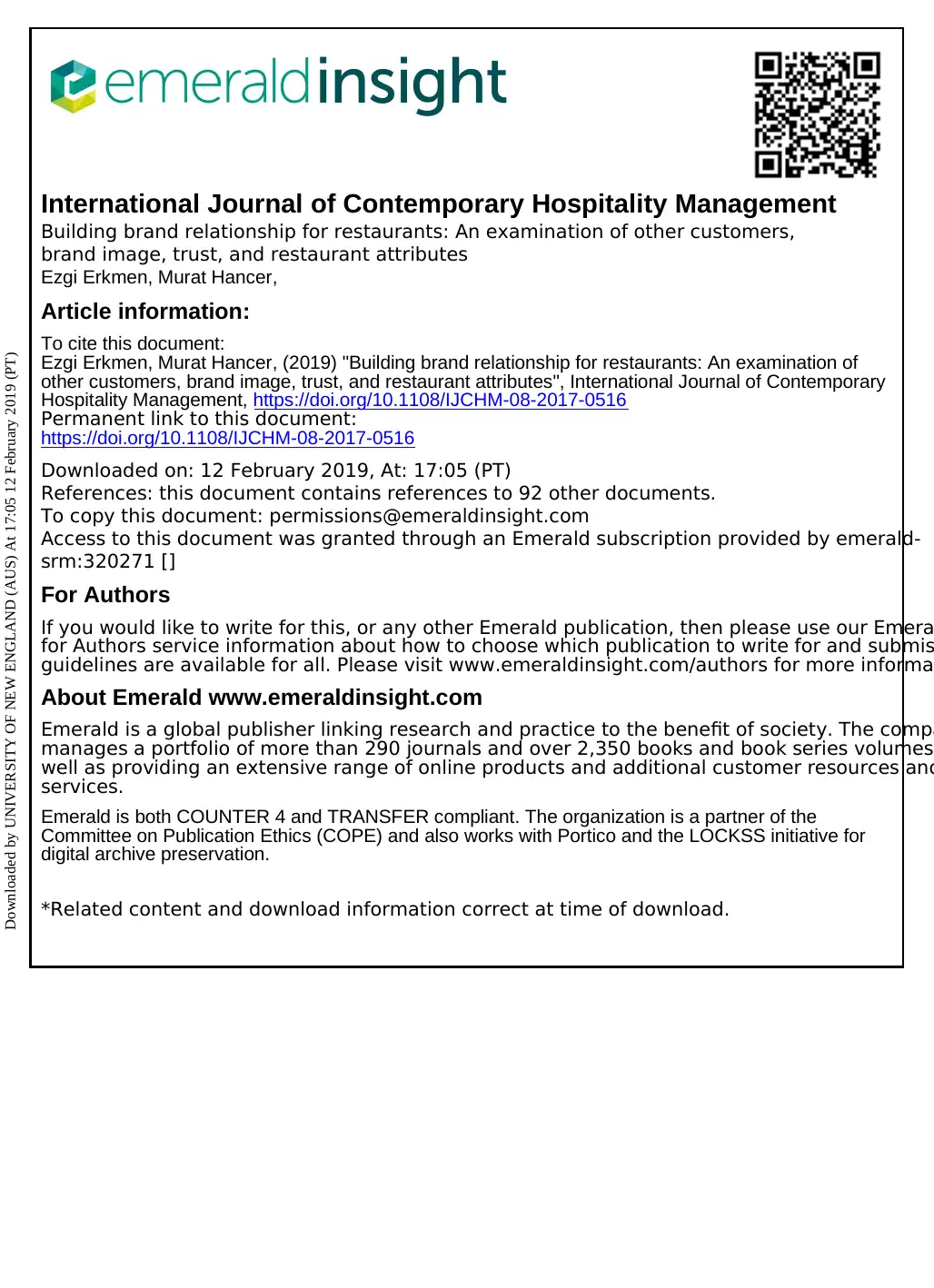
International Journal of Contemporary Hospitality Management
Building brand relationship for restaurants: An examination of other customers,
brand image, trust, and restaurant attributes
Ezgi Erkmen, Murat Hancer,
Article information:
To cite this document:
Ezgi Erkmen, Murat Hancer, (2019) "Building brand relationship for restaurants: An examination of
other customers, brand image, trust, and restaurant attributes", International Journal of Contemporary
Hospitality Management, https://doi.org/10.1108/IJCHM-08-2017-0516
Permanent link to this document:
https://doi.org/10.1108/IJCHM-08-2017-0516
Downloaded on: 12 February 2019, At: 17:05 (PT)
References: this document contains references to 92 other documents.
To copy this document: permissions@emeraldinsight.com
Access to this document was granted through an Emerald subscription provided by emerald-
srm:320271 []
For Authors
If you would like to write for this, or any other Emerald publication, then please use our Emera
for Authors service information about how to choose which publication to write for and submis
guidelines are available for all. Please visit www.emeraldinsight.com/authors for more informa
About Emerald www.emeraldinsight.com
Emerald is a global publisher linking research and practice to the benefit of society. The compa
manages a portfolio of more than 290 journals and over 2,350 books and book series volumes
well as providing an extensive range of online products and additional customer resources and
services.
Emerald is both COUNTER 4 and TRANSFER compliant. The organization is a partner of the
Committee on Publication Ethics (COPE) and also works with Portico and the LOCKSS initiative for
digital archive preservation.
*Related content and download information correct at time of download.
Downloaded by UNIVERSITY OF NEW ENGLAND (AUS) At 17:05 12 February 2019 (PT)
Building brand relationship for restaurants: An examination of other customers,
brand image, trust, and restaurant attributes
Ezgi Erkmen, Murat Hancer,
Article information:
To cite this document:
Ezgi Erkmen, Murat Hancer, (2019) "Building brand relationship for restaurants: An examination of
other customers, brand image, trust, and restaurant attributes", International Journal of Contemporary
Hospitality Management, https://doi.org/10.1108/IJCHM-08-2017-0516
Permanent link to this document:
https://doi.org/10.1108/IJCHM-08-2017-0516
Downloaded on: 12 February 2019, At: 17:05 (PT)
References: this document contains references to 92 other documents.
To copy this document: permissions@emeraldinsight.com
Access to this document was granted through an Emerald subscription provided by emerald-
srm:320271 []
For Authors
If you would like to write for this, or any other Emerald publication, then please use our Emera
for Authors service information about how to choose which publication to write for and submis
guidelines are available for all. Please visit www.emeraldinsight.com/authors for more informa
About Emerald www.emeraldinsight.com
Emerald is a global publisher linking research and practice to the benefit of society. The compa
manages a portfolio of more than 290 journals and over 2,350 books and book series volumes
well as providing an extensive range of online products and additional customer resources and
services.
Emerald is both COUNTER 4 and TRANSFER compliant. The organization is a partner of the
Committee on Publication Ethics (COPE) and also works with Portico and the LOCKSS initiative for
digital archive preservation.
*Related content and download information correct at time of download.
Downloaded by UNIVERSITY OF NEW ENGLAND (AUS) At 17:05 12 February 2019 (PT)
Paraphrase This Document
Need a fresh take? Get an instant paraphrase of this document with our AI Paraphraser
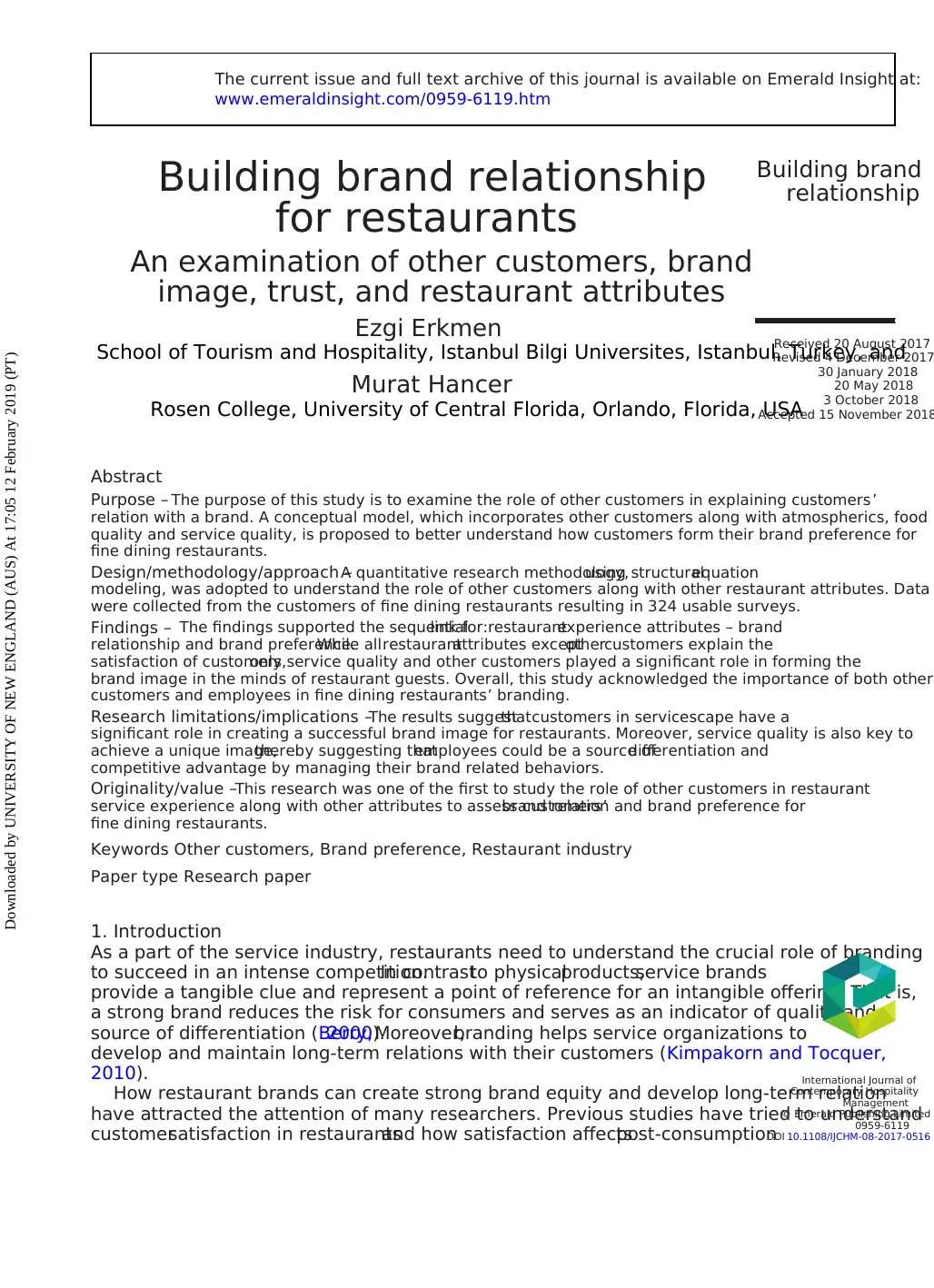
Building brand relationship
for restaurants
An examination of other customers, brand
image, trust, and restaurant attributes
Ezgi Erkmen
School of Tourism and Hospitality, Istanbul Bilgi Universites, Istanbul, Turkey, and
Murat Hancer
Rosen College, University of Central Florida, Orlando, Florida, USA
Abstract
Purpose – The purpose of this study is to examine the role of other customers in explaining customers’
relation with a brand. A conceptual model, which incorporates other customers along with atmospherics, food
quality and service quality, is proposed to better understand how customers form their brand preference for
fine dining restaurants.
Design/methodology/approach –A quantitative research methodology,using structuralequation
modeling, was adopted to understand the role of other customers along with other restaurant attributes. Data
were collected from the customers of fine dining restaurants resulting in 324 usable surveys.
Findings – The findings supported the sequentiallink for:restaurantexperience attributes – brand
relationship and brand preference.While allrestaurantattributes exceptothercustomers explain the
satisfaction of customers,only service quality and other customers played a significant role in forming the
brand image in the minds of restaurant guests. Overall, this study acknowledged the importance of both other
customers and employees in fine dining restaurants’ branding.
Research limitations/implications –The results suggestthatcustomers in servicescape have a
significant role in creating a successful brand image for restaurants. Moreover, service quality is also key to
achieve a unique image,thereby suggesting thatemployees could be a source ofdifferentiation and
competitive advantage by managing their brand related behaviors.
Originality/value –This research was one of the first to study the role of other customers in restaurant
service experience along with other attributes to assess customers’brand relation and brand preference for
fine dining restaurants.
Keywords Other customers, Brand preference, Restaurant industry
Paper type Research paper
1. Introduction
As a part of the service industry, restaurants need to understand the crucial role of branding
to succeed in an intense competition.In contrastto physicalproducts,service brands
provide a tangible clue and represent a point of reference for an intangible offering. That is,
a strong brand reduces the risk for consumers and serves as an indicator of quality and a
source of differentiation (Berry,2000).Moreover,branding helps service organizations to
develop and maintain long-term relations with their customers (Kimpakorn and Tocquer,
2010).
How restaurant brands can create strong brand equity and develop long-term relation
have attracted the attention of many researchers. Previous studies have tried to understand
customersatisfaction in restaurantsand how satisfaction affectspost-consumption
Building brand
relationship
Received 20 August 2017
Revised 4 December 2017
30 January 2018
20 May 2018
3 October 2018
Accepted 15 November 2018
International Journal of
Contemporary Hospitality
Management
© Emerald Publishing Limited
0959-6119
DOI 10.1108/IJCHM-08-2017-0516
The current issue and full text archive of this journal is available on Emerald Insight at:
www.emeraldinsight.com/0959-6119.htm
Downloaded by UNIVERSITY OF NEW ENGLAND (AUS) At 17:05 12 February 2019 (PT)
for restaurants
An examination of other customers, brand
image, trust, and restaurant attributes
Ezgi Erkmen
School of Tourism and Hospitality, Istanbul Bilgi Universites, Istanbul, Turkey, and
Murat Hancer
Rosen College, University of Central Florida, Orlando, Florida, USA
Abstract
Purpose – The purpose of this study is to examine the role of other customers in explaining customers’
relation with a brand. A conceptual model, which incorporates other customers along with atmospherics, food
quality and service quality, is proposed to better understand how customers form their brand preference for
fine dining restaurants.
Design/methodology/approach –A quantitative research methodology,using structuralequation
modeling, was adopted to understand the role of other customers along with other restaurant attributes. Data
were collected from the customers of fine dining restaurants resulting in 324 usable surveys.
Findings – The findings supported the sequentiallink for:restaurantexperience attributes – brand
relationship and brand preference.While allrestaurantattributes exceptothercustomers explain the
satisfaction of customers,only service quality and other customers played a significant role in forming the
brand image in the minds of restaurant guests. Overall, this study acknowledged the importance of both other
customers and employees in fine dining restaurants’ branding.
Research limitations/implications –The results suggestthatcustomers in servicescape have a
significant role in creating a successful brand image for restaurants. Moreover, service quality is also key to
achieve a unique image,thereby suggesting thatemployees could be a source ofdifferentiation and
competitive advantage by managing their brand related behaviors.
Originality/value –This research was one of the first to study the role of other customers in restaurant
service experience along with other attributes to assess customers’brand relation and brand preference for
fine dining restaurants.
Keywords Other customers, Brand preference, Restaurant industry
Paper type Research paper
1. Introduction
As a part of the service industry, restaurants need to understand the crucial role of branding
to succeed in an intense competition.In contrastto physicalproducts,service brands
provide a tangible clue and represent a point of reference for an intangible offering. That is,
a strong brand reduces the risk for consumers and serves as an indicator of quality and a
source of differentiation (Berry,2000).Moreover,branding helps service organizations to
develop and maintain long-term relations with their customers (Kimpakorn and Tocquer,
2010).
How restaurant brands can create strong brand equity and develop long-term relation
have attracted the attention of many researchers. Previous studies have tried to understand
customersatisfaction in restaurantsand how satisfaction affectspost-consumption
Building brand
relationship
Received 20 August 2017
Revised 4 December 2017
30 January 2018
20 May 2018
3 October 2018
Accepted 15 November 2018
International Journal of
Contemporary Hospitality
Management
© Emerald Publishing Limited
0959-6119
DOI 10.1108/IJCHM-08-2017-0516
The current issue and full text archive of this journal is available on Emerald Insight at:
www.emeraldinsight.com/0959-6119.htm
Downloaded by UNIVERSITY OF NEW ENGLAND (AUS) At 17:05 12 February 2019 (PT)
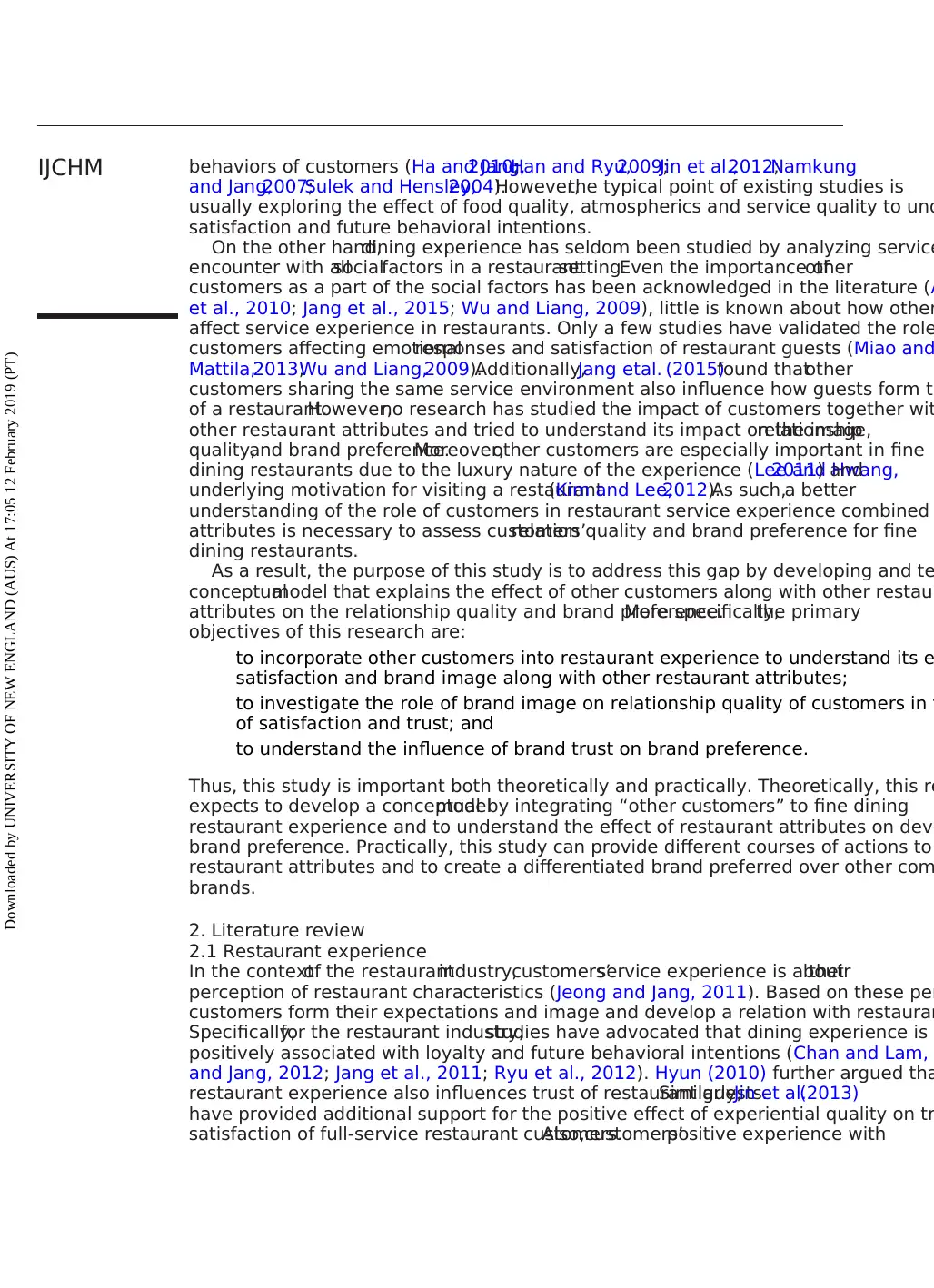
behaviors of customers (Ha and Jang,2010;Han and Ryu,2009;Jin et al.,2012;Namkung
and Jang,2007;Sulek and Hensley,2004).However,the typical point of existing studies is
usually exploring the effect of food quality, atmospherics and service quality to und
satisfaction and future behavioral intentions.
On the other hand,dining experience has seldom been studied by analyzing service
encounter with allsocialfactors in a restaurantsetting.Even the importance ofother
customers as a part of the social factors has been acknowledged in the literature (A
et al., 2010; Jang et al., 2015; Wu and Liang, 2009), little is known about how other
affect service experience in restaurants. Only a few studies have validated the role
customers affecting emotionalresponses and satisfaction of restaurant guests (Miao and
Mattila,2013;Wu and Liang,2009).Additionally,Jang etal. (2015)found thatother
customers sharing the same service environment also influence how guests form th
of a restaurant.However,no research has studied the impact of customers together wit
other restaurant attributes and tried to understand its impact on the image,relationship
quality,and brand preference.Moreover,other customers are especially important in fine
dining restaurants due to the luxury nature of the experience (Lee and Hwang,2011) and
underlying motivation for visiting a restaurant(Kim and Lee,2012).As such,a better
understanding of the role of customers in restaurant service experience combined
attributes is necessary to assess customers’relation quality and brand preference for fine
dining restaurants.
As a result, the purpose of this study is to address this gap by developing and te
conceptualmodel that explains the effect of other customers along with other restaur
attributes on the relationship quality and brand preference.More specifically,the primary
objectives of this research are:
to incorporate other customers into restaurant experience to understand its e
satisfaction and brand image along with other restaurant attributes;
to investigate the role of brand image on relationship quality of customers in t
of satisfaction and trust; and
to understand the influence of brand trust on brand preference.
Thus, this study is important both theoretically and practically. Theoretically, this re
expects to develop a conceptualmodelby integrating “other customers” to fine dining
restaurant experience and to understand the effect of restaurant attributes on deve
brand preference. Practically, this study can provide different courses of actions to
restaurant attributes and to create a differentiated brand preferred over other com
brands.
2. Literature review
2.1 Restaurant experience
In the contextof the restaurantindustry,customers’service experience is abouttheir
perception of restaurant characteristics (Jeong and Jang, 2011). Based on these per
customers form their expectations and image and develop a relation with restauran
Specifically,for the restaurant industry,studies have advocated that dining experience is
positively associated with loyalty and future behavioral intentions (Chan and Lam,
and Jang, 2012; Jang et al., 2011; Ryu et al., 2012). Hyun (2010) further argued tha
restaurant experience also influences trust of restaurant guests.Similarly,Jin et al.(2013)
have provided additional support for the positive effect of experiential quality on tr
satisfaction of full-service restaurant customers.Also,customers’positive experience with
IJCHM
Downloaded by UNIVERSITY OF NEW ENGLAND (AUS) At 17:05 12 February 2019 (PT)
and Jang,2007;Sulek and Hensley,2004).However,the typical point of existing studies is
usually exploring the effect of food quality, atmospherics and service quality to und
satisfaction and future behavioral intentions.
On the other hand,dining experience has seldom been studied by analyzing service
encounter with allsocialfactors in a restaurantsetting.Even the importance ofother
customers as a part of the social factors has been acknowledged in the literature (A
et al., 2010; Jang et al., 2015; Wu and Liang, 2009), little is known about how other
affect service experience in restaurants. Only a few studies have validated the role
customers affecting emotionalresponses and satisfaction of restaurant guests (Miao and
Mattila,2013;Wu and Liang,2009).Additionally,Jang etal. (2015)found thatother
customers sharing the same service environment also influence how guests form th
of a restaurant.However,no research has studied the impact of customers together wit
other restaurant attributes and tried to understand its impact on the image,relationship
quality,and brand preference.Moreover,other customers are especially important in fine
dining restaurants due to the luxury nature of the experience (Lee and Hwang,2011) and
underlying motivation for visiting a restaurant(Kim and Lee,2012).As such,a better
understanding of the role of customers in restaurant service experience combined
attributes is necessary to assess customers’relation quality and brand preference for fine
dining restaurants.
As a result, the purpose of this study is to address this gap by developing and te
conceptualmodel that explains the effect of other customers along with other restaur
attributes on the relationship quality and brand preference.More specifically,the primary
objectives of this research are:
to incorporate other customers into restaurant experience to understand its e
satisfaction and brand image along with other restaurant attributes;
to investigate the role of brand image on relationship quality of customers in t
of satisfaction and trust; and
to understand the influence of brand trust on brand preference.
Thus, this study is important both theoretically and practically. Theoretically, this re
expects to develop a conceptualmodelby integrating “other customers” to fine dining
restaurant experience and to understand the effect of restaurant attributes on deve
brand preference. Practically, this study can provide different courses of actions to
restaurant attributes and to create a differentiated brand preferred over other com
brands.
2. Literature review
2.1 Restaurant experience
In the contextof the restaurantindustry,customers’service experience is abouttheir
perception of restaurant characteristics (Jeong and Jang, 2011). Based on these per
customers form their expectations and image and develop a relation with restauran
Specifically,for the restaurant industry,studies have advocated that dining experience is
positively associated with loyalty and future behavioral intentions (Chan and Lam,
and Jang, 2012; Jang et al., 2011; Ryu et al., 2012). Hyun (2010) further argued tha
restaurant experience also influences trust of restaurant guests.Similarly,Jin et al.(2013)
have provided additional support for the positive effect of experiential quality on tr
satisfaction of full-service restaurant customers.Also,customers’positive experience with
IJCHM
Downloaded by UNIVERSITY OF NEW ENGLAND (AUS) At 17:05 12 February 2019 (PT)
⊘ This is a preview!⊘
Do you want full access?
Subscribe today to unlock all pages.

Trusted by 1+ million students worldwide
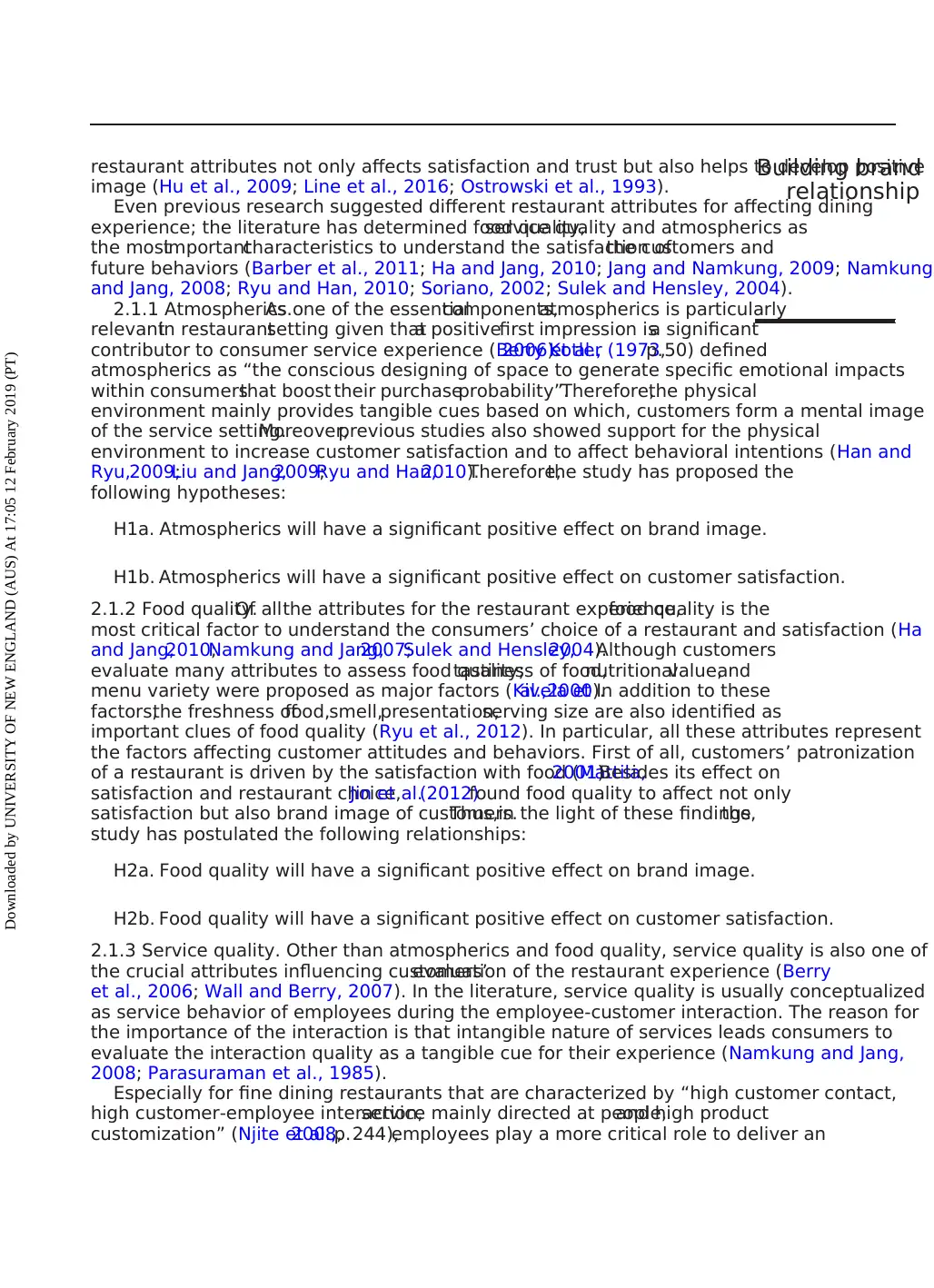
restaurant attributes not only affects satisfaction and trust but also helps to develop positive
image (Hu et al., 2009; Line et al., 2016; Ostrowski et al., 1993).
Even previous research suggested different restaurant attributes for affecting dining
experience; the literature has determined food quality,service quality and atmospherics as
the mostimportantcharacteristics to understand the satisfaction ofthe customers and
future behaviors (Barber et al., 2011; Ha and Jang, 2010; Jang and Namkung, 2009; Namkung
and Jang, 2008; Ryu and Han, 2010; Soriano, 2002; Sulek and Hensley, 2004).
2.1.1 Atmospherics.As one of the essentialcomponents,atmospherics is particularly
relevantin restaurantsetting given thata positivefirst impression isa significant
contributor to consumer service experience (Berry et al.,2006).Kotler (1973,p.50) defined
atmospherics as “the conscious designing of space to generate specific emotional impacts
within consumersthat boost their purchaseprobability”.Therefore,the physical
environment mainly provides tangible cues based on which, customers form a mental image
of the service setting.Moreover,previous studies also showed support for the physical
environment to increase customer satisfaction and to affect behavioral intentions (Han and
Ryu,2009;Liu and Jang,2009;Ryu and Han,2010).Therefore,the study has proposed the
following hypotheses:
H1a. Atmospherics will have a significant positive effect on brand image.
H1b. Atmospherics will have a significant positive effect on customer satisfaction.
2.1.2 Food quality.Of allthe attributes for the restaurant experience,food quality is the
most critical factor to understand the consumers’ choice of a restaurant and satisfaction (Ha
and Jang,2010;Namkung and Jang,2007;Sulek and Hensley,2004).Although customers
evaluate many attributes to assess food quality;tastiness of food,nutritionalvalue,and
menu variety were proposed as major factors (Kivela etal.,2000).In addition to these
factors,the freshness offood,smell,presentation,serving size are also identified as
important clues of food quality (Ryu et al., 2012). In particular, all these attributes represent
the factors affecting customer attitudes and behaviors. First of all, customers’ patronization
of a restaurant is driven by the satisfaction with food (Mattila,2001).Besides its effect on
satisfaction and restaurant choice,Jin et al.(2012)found food quality to affect not only
satisfaction but also brand image of customers.Thus,in the light of these findings,the
study has postulated the following relationships:
H2a. Food quality will have a significant positive effect on brand image.
H2b. Food quality will have a significant positive effect on customer satisfaction.
2.1.3 Service quality. Other than atmospherics and food quality, service quality is also one of
the crucial attributes influencing customers’evaluation of the restaurant experience (Berry
et al., 2006; Wall and Berry, 2007). In the literature, service quality is usually conceptualized
as service behavior of employees during the employee-customer interaction. The reason for
the importance of the interaction is that intangible nature of services leads consumers to
evaluate the interaction quality as a tangible cue for their experience (Namkung and Jang,
2008; Parasuraman et al., 1985).
Especially for fine dining restaurants that are characterized by “high customer contact,
high customer-employee interaction,service mainly directed at people,and high product
customization” (Njite et al.,2008,p.244),employees play a more critical role to deliver an
Building brand
relationship
Downloaded by UNIVERSITY OF NEW ENGLAND (AUS) At 17:05 12 February 2019 (PT)
image (Hu et al., 2009; Line et al., 2016; Ostrowski et al., 1993).
Even previous research suggested different restaurant attributes for affecting dining
experience; the literature has determined food quality,service quality and atmospherics as
the mostimportantcharacteristics to understand the satisfaction ofthe customers and
future behaviors (Barber et al., 2011; Ha and Jang, 2010; Jang and Namkung, 2009; Namkung
and Jang, 2008; Ryu and Han, 2010; Soriano, 2002; Sulek and Hensley, 2004).
2.1.1 Atmospherics.As one of the essentialcomponents,atmospherics is particularly
relevantin restaurantsetting given thata positivefirst impression isa significant
contributor to consumer service experience (Berry et al.,2006).Kotler (1973,p.50) defined
atmospherics as “the conscious designing of space to generate specific emotional impacts
within consumersthat boost their purchaseprobability”.Therefore,the physical
environment mainly provides tangible cues based on which, customers form a mental image
of the service setting.Moreover,previous studies also showed support for the physical
environment to increase customer satisfaction and to affect behavioral intentions (Han and
Ryu,2009;Liu and Jang,2009;Ryu and Han,2010).Therefore,the study has proposed the
following hypotheses:
H1a. Atmospherics will have a significant positive effect on brand image.
H1b. Atmospherics will have a significant positive effect on customer satisfaction.
2.1.2 Food quality.Of allthe attributes for the restaurant experience,food quality is the
most critical factor to understand the consumers’ choice of a restaurant and satisfaction (Ha
and Jang,2010;Namkung and Jang,2007;Sulek and Hensley,2004).Although customers
evaluate many attributes to assess food quality;tastiness of food,nutritionalvalue,and
menu variety were proposed as major factors (Kivela etal.,2000).In addition to these
factors,the freshness offood,smell,presentation,serving size are also identified as
important clues of food quality (Ryu et al., 2012). In particular, all these attributes represent
the factors affecting customer attitudes and behaviors. First of all, customers’ patronization
of a restaurant is driven by the satisfaction with food (Mattila,2001).Besides its effect on
satisfaction and restaurant choice,Jin et al.(2012)found food quality to affect not only
satisfaction but also brand image of customers.Thus,in the light of these findings,the
study has postulated the following relationships:
H2a. Food quality will have a significant positive effect on brand image.
H2b. Food quality will have a significant positive effect on customer satisfaction.
2.1.3 Service quality. Other than atmospherics and food quality, service quality is also one of
the crucial attributes influencing customers’evaluation of the restaurant experience (Berry
et al., 2006; Wall and Berry, 2007). In the literature, service quality is usually conceptualized
as service behavior of employees during the employee-customer interaction. The reason for
the importance of the interaction is that intangible nature of services leads consumers to
evaluate the interaction quality as a tangible cue for their experience (Namkung and Jang,
2008; Parasuraman et al., 1985).
Especially for fine dining restaurants that are characterized by “high customer contact,
high customer-employee interaction,service mainly directed at people,and high product
customization” (Njite et al.,2008,p.244),employees play a more critical role to deliver an
Building brand
relationship
Downloaded by UNIVERSITY OF NEW ENGLAND (AUS) At 17:05 12 February 2019 (PT)
Paraphrase This Document
Need a fresh take? Get an instant paraphrase of this document with our AI Paraphraser
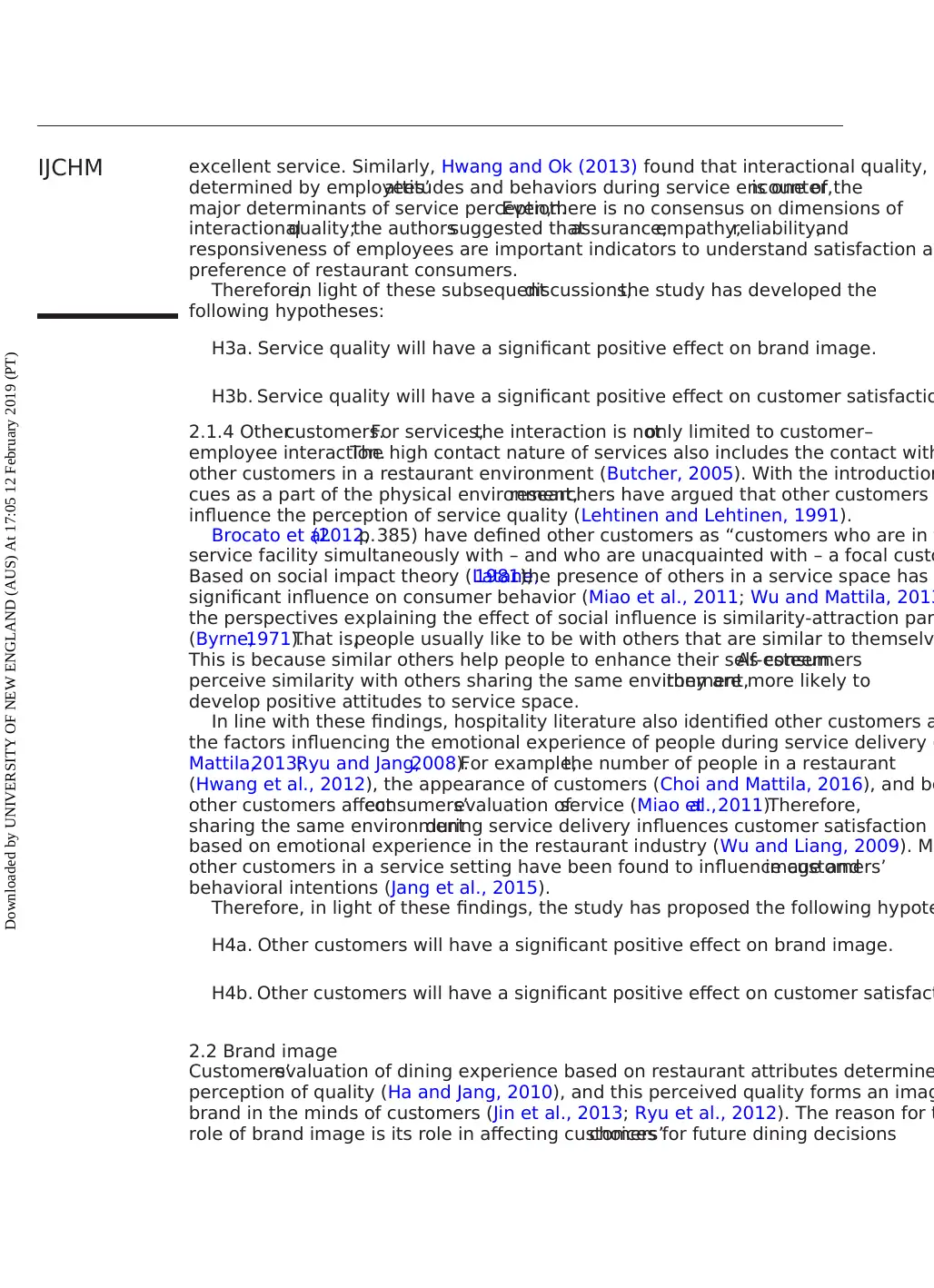
excellent service. Similarly, Hwang and Ok (2013) found that interactional quality, w
determined by employees’attitudes and behaviors during service encounter,is one of the
major determinants of service perception.Even,there is no consensus on dimensions of
interactionalquality;the authorssuggested thatassurance,empathy,reliability,and
responsiveness of employees are important indicators to understand satisfaction an
preference of restaurant consumers.
Therefore,in light of these subsequentdiscussions,the study has developed the
following hypotheses:
H3a. Service quality will have a significant positive effect on brand image.
H3b. Service quality will have a significant positive effect on customer satisfactio
2.1.4 Othercustomers.For services,the interaction is notonly limited to customer–
employee interaction.The high contact nature of services also includes the contact with
other customers in a restaurant environment (Butcher, 2005). With the introduction
cues as a part of the physical environment,researchers have argued that other customers
influence the perception of service quality (Lehtinen and Lehtinen, 1991).
Brocato et al.(2012,p.385) have defined other customers as “customers who are in t
service facility simultaneously with – and who are unacquainted with – a focal custo
Based on social impact theory (Latane,1981),the presence of others in a service space has
significant influence on consumer behavior (Miao et al., 2011; Wu and Mattila, 2013
the perspectives explaining the effect of social influence is similarity-attraction par
(Byrne,1971).That is,people usually like to be with others that are similar to themselv
This is because similar others help people to enhance their self-esteem.As consumers
perceive similarity with others sharing the same environment,they are more likely to
develop positive attitudes to service space.
In line with these findings, hospitality literature also identified other customers a
the factors influencing the emotional experience of people during service delivery (
Mattila,2013;Ryu and Jang,2008).For example,the number of people in a restaurant
(Hwang et al., 2012), the appearance of customers (Choi and Mattila, 2016), and be
other customers affectconsumers’evaluation ofservice (Miao etal.,2011).Therefore,
sharing the same environmentduring service delivery influences customer satisfaction
based on emotional experience in the restaurant industry (Wu and Liang, 2009). Mo
other customers in a service setting have been found to influence customers’image and
behavioral intentions (Jang et al., 2015).
Therefore, in light of these findings, the study has proposed the following hypote
H4a. Other customers will have a significant positive effect on brand image.
H4b. Other customers will have a significant positive effect on customer satisfact
2.2 Brand image
Customers’evaluation of dining experience based on restaurant attributes determine
perception of quality (Ha and Jang, 2010), and this perceived quality forms an imag
brand in the minds of customers (Jin et al., 2013; Ryu et al., 2012). The reason for t
role of brand image is its role in affecting customers’choices for future dining decisions
IJCHM
Downloaded by UNIVERSITY OF NEW ENGLAND (AUS) At 17:05 12 February 2019 (PT)
determined by employees’attitudes and behaviors during service encounter,is one of the
major determinants of service perception.Even,there is no consensus on dimensions of
interactionalquality;the authorssuggested thatassurance,empathy,reliability,and
responsiveness of employees are important indicators to understand satisfaction an
preference of restaurant consumers.
Therefore,in light of these subsequentdiscussions,the study has developed the
following hypotheses:
H3a. Service quality will have a significant positive effect on brand image.
H3b. Service quality will have a significant positive effect on customer satisfactio
2.1.4 Othercustomers.For services,the interaction is notonly limited to customer–
employee interaction.The high contact nature of services also includes the contact with
other customers in a restaurant environment (Butcher, 2005). With the introduction
cues as a part of the physical environment,researchers have argued that other customers
influence the perception of service quality (Lehtinen and Lehtinen, 1991).
Brocato et al.(2012,p.385) have defined other customers as “customers who are in t
service facility simultaneously with – and who are unacquainted with – a focal custo
Based on social impact theory (Latane,1981),the presence of others in a service space has
significant influence on consumer behavior (Miao et al., 2011; Wu and Mattila, 2013
the perspectives explaining the effect of social influence is similarity-attraction par
(Byrne,1971).That is,people usually like to be with others that are similar to themselv
This is because similar others help people to enhance their self-esteem.As consumers
perceive similarity with others sharing the same environment,they are more likely to
develop positive attitudes to service space.
In line with these findings, hospitality literature also identified other customers a
the factors influencing the emotional experience of people during service delivery (
Mattila,2013;Ryu and Jang,2008).For example,the number of people in a restaurant
(Hwang et al., 2012), the appearance of customers (Choi and Mattila, 2016), and be
other customers affectconsumers’evaluation ofservice (Miao etal.,2011).Therefore,
sharing the same environmentduring service delivery influences customer satisfaction
based on emotional experience in the restaurant industry (Wu and Liang, 2009). Mo
other customers in a service setting have been found to influence customers’image and
behavioral intentions (Jang et al., 2015).
Therefore, in light of these findings, the study has proposed the following hypote
H4a. Other customers will have a significant positive effect on brand image.
H4b. Other customers will have a significant positive effect on customer satisfact
2.2 Brand image
Customers’evaluation of dining experience based on restaurant attributes determine
perception of quality (Ha and Jang, 2010), and this perceived quality forms an imag
brand in the minds of customers (Jin et al., 2013; Ryu et al., 2012). The reason for t
role of brand image is its role in affecting customers’choices for future dining decisions
IJCHM
Downloaded by UNIVERSITY OF NEW ENGLAND (AUS) At 17:05 12 February 2019 (PT)
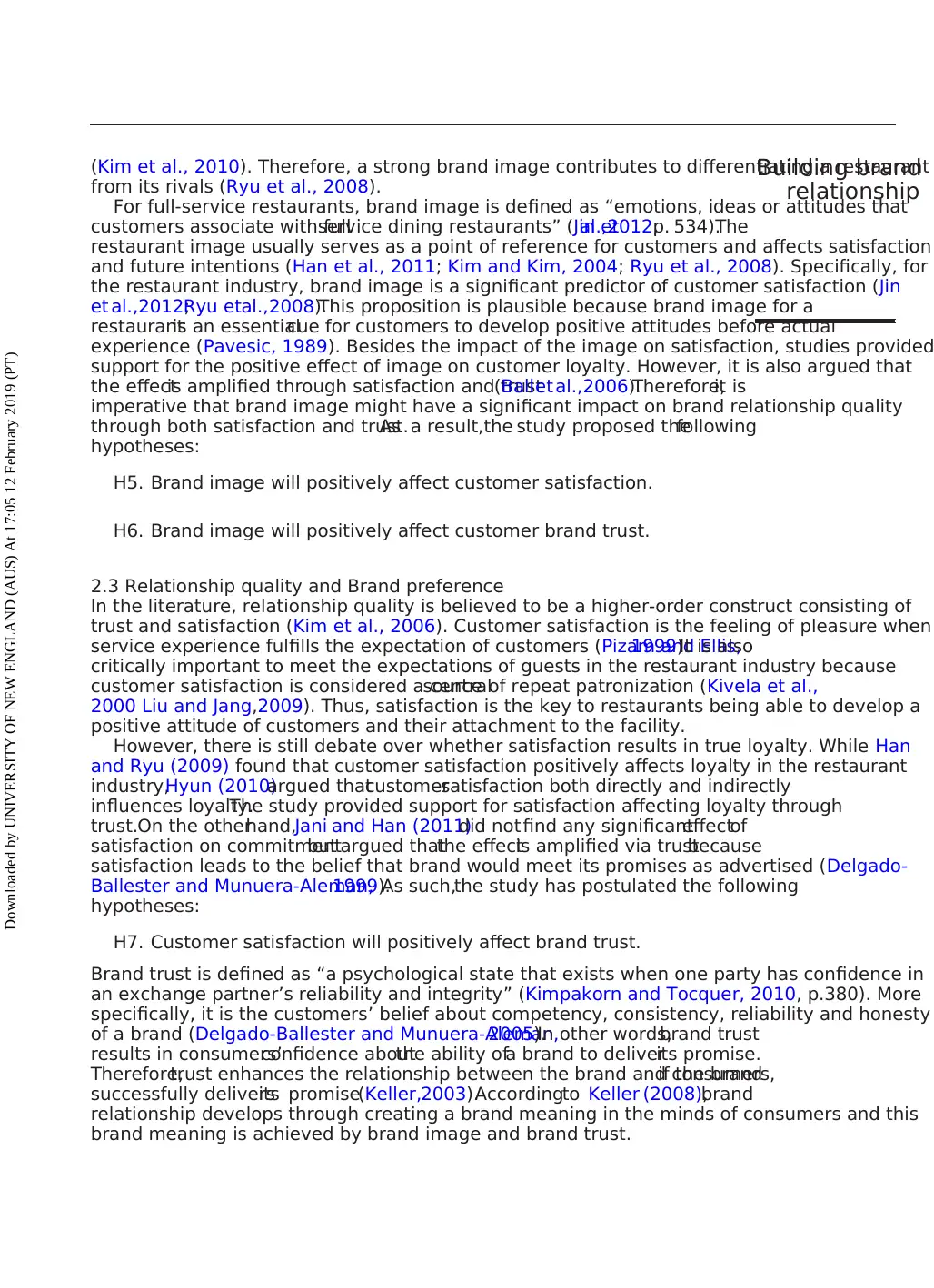
(Kim et al., 2010). Therefore, a strong brand image contributes to differentiating a restaurant
from its rivals (Ryu et al., 2008).
For full-service restaurants, brand image is defined as “emotions, ideas or attitudes that
customers associate with fullservice dining restaurants” (Jin etal.,2012,p. 534).The
restaurant image usually serves as a point of reference for customers and affects satisfaction
and future intentions (Han et al., 2011; Kim and Kim, 2004; Ryu et al., 2008). Specifically, for
the restaurant industry, brand image is a significant predictor of customer satisfaction (Jin
et al.,2012;Ryu etal.,2008).This proposition is plausible because brand image for a
restaurantis an essentialcue for customers to develop positive attitudes before actual
experience (Pavesic, 1989). Besides the impact of the image on satisfaction, studies provided
support for the positive effect of image on customer loyalty. However, it is also argued that
the effectis amplified through satisfaction and trust(Ballet al.,2006).Therefore,it is
imperative that brand image might have a significant impact on brand relationship quality
through both satisfaction and trust.As a result,the study proposed thefollowing
hypotheses:
H5. Brand image will positively affect customer satisfaction.
H6. Brand image will positively affect customer brand trust.
2.3 Relationship quality and Brand preference
In the literature, relationship quality is believed to be a higher-order construct consisting of
trust and satisfaction (Kim et al., 2006). Customer satisfaction is the feeling of pleasure when
service experience fulfills the expectation of customers (Pizam and Ellis,1999).It is also
critically important to meet the expectations of guests in the restaurant industry because
customer satisfaction is considered a centralsource of repeat patronization (Kivela et al.,
2000 Liu and Jang,2009). Thus, satisfaction is the key to restaurants being able to develop a
positive attitude of customers and their attachment to the facility.
However, there is still debate over whether satisfaction results in true loyalty. While Han
and Ryu (2009) found that customer satisfaction positively affects loyalty in the restaurant
industry,Hyun (2010)argued thatcustomersatisfaction both directly and indirectly
influences loyalty.The study provided support for satisfaction affecting loyalty through
trust.On the otherhand,Jani and Han (2011)did not find any significanteffectof
satisfaction on commitmentbut argued thatthe effectis amplified via trustbecause
satisfaction leads to the belief that brand would meet its promises as advertised (Delgado-
Ballester and Munuera-Aleman,1999).As such,the study has postulated the following
hypotheses:
H7. Customer satisfaction will positively affect brand trust.
Brand trust is defined as “a psychological state that exists when one party has confidence in
an exchange partner’s reliability and integrity” (Kimpakorn and Tocquer, 2010, p.380). More
specifically, it is the customers’ belief about competency, consistency, reliability and honesty
of a brand (Delgado-Ballester and Munuera-Aleman,2005).In other words,brand trust
results in consumers’confidence aboutthe ability ofa brand to deliverits promise.
Therefore,trust enhances the relationship between the brand and consumers,if the brand
successfully deliversits promise(Keller,2003).Accordingto Keller (2008),brand
relationship develops through creating a brand meaning in the minds of consumers and this
brand meaning is achieved by brand image and brand trust.
Building brand
relationship
Downloaded by UNIVERSITY OF NEW ENGLAND (AUS) At 17:05 12 February 2019 (PT)
from its rivals (Ryu et al., 2008).
For full-service restaurants, brand image is defined as “emotions, ideas or attitudes that
customers associate with fullservice dining restaurants” (Jin etal.,2012,p. 534).The
restaurant image usually serves as a point of reference for customers and affects satisfaction
and future intentions (Han et al., 2011; Kim and Kim, 2004; Ryu et al., 2008). Specifically, for
the restaurant industry, brand image is a significant predictor of customer satisfaction (Jin
et al.,2012;Ryu etal.,2008).This proposition is plausible because brand image for a
restaurantis an essentialcue for customers to develop positive attitudes before actual
experience (Pavesic, 1989). Besides the impact of the image on satisfaction, studies provided
support for the positive effect of image on customer loyalty. However, it is also argued that
the effectis amplified through satisfaction and trust(Ballet al.,2006).Therefore,it is
imperative that brand image might have a significant impact on brand relationship quality
through both satisfaction and trust.As a result,the study proposed thefollowing
hypotheses:
H5. Brand image will positively affect customer satisfaction.
H6. Brand image will positively affect customer brand trust.
2.3 Relationship quality and Brand preference
In the literature, relationship quality is believed to be a higher-order construct consisting of
trust and satisfaction (Kim et al., 2006). Customer satisfaction is the feeling of pleasure when
service experience fulfills the expectation of customers (Pizam and Ellis,1999).It is also
critically important to meet the expectations of guests in the restaurant industry because
customer satisfaction is considered a centralsource of repeat patronization (Kivela et al.,
2000 Liu and Jang,2009). Thus, satisfaction is the key to restaurants being able to develop a
positive attitude of customers and their attachment to the facility.
However, there is still debate over whether satisfaction results in true loyalty. While Han
and Ryu (2009) found that customer satisfaction positively affects loyalty in the restaurant
industry,Hyun (2010)argued thatcustomersatisfaction both directly and indirectly
influences loyalty.The study provided support for satisfaction affecting loyalty through
trust.On the otherhand,Jani and Han (2011)did not find any significanteffectof
satisfaction on commitmentbut argued thatthe effectis amplified via trustbecause
satisfaction leads to the belief that brand would meet its promises as advertised (Delgado-
Ballester and Munuera-Aleman,1999).As such,the study has postulated the following
hypotheses:
H7. Customer satisfaction will positively affect brand trust.
Brand trust is defined as “a psychological state that exists when one party has confidence in
an exchange partner’s reliability and integrity” (Kimpakorn and Tocquer, 2010, p.380). More
specifically, it is the customers’ belief about competency, consistency, reliability and honesty
of a brand (Delgado-Ballester and Munuera-Aleman,2005).In other words,brand trust
results in consumers’confidence aboutthe ability ofa brand to deliverits promise.
Therefore,trust enhances the relationship between the brand and consumers,if the brand
successfully deliversits promise(Keller,2003).Accordingto Keller (2008),brand
relationship develops through creating a brand meaning in the minds of consumers and this
brand meaning is achieved by brand image and brand trust.
Building brand
relationship
Downloaded by UNIVERSITY OF NEW ENGLAND (AUS) At 17:05 12 February 2019 (PT)
⊘ This is a preview!⊘
Do you want full access?
Subscribe today to unlock all pages.

Trusted by 1+ million students worldwide
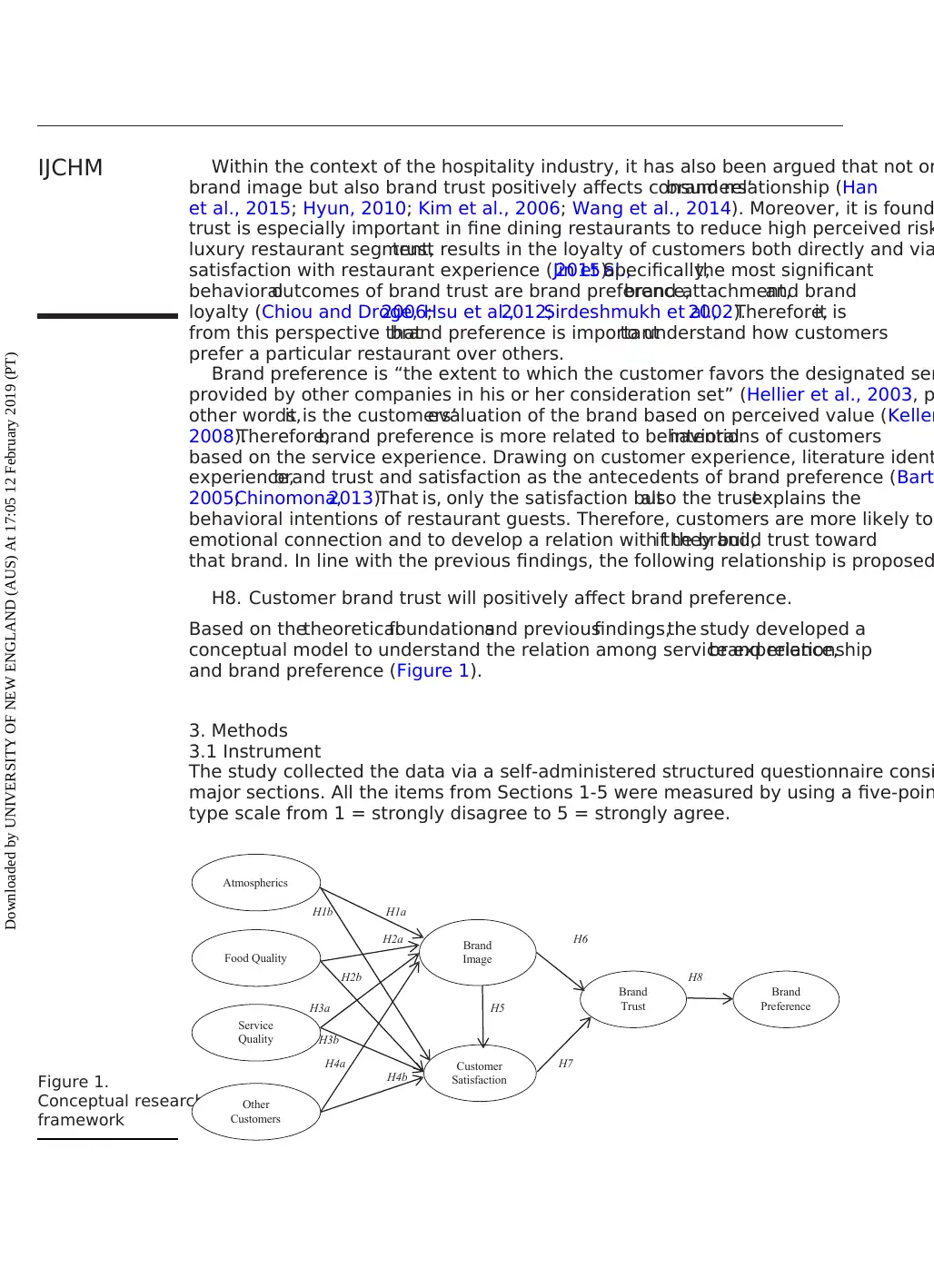
Within the context of the hospitality industry, it has also been argued that not on
brand image but also brand trust positively affects consumers’brand relationship (Han
et al., 2015; Hyun, 2010; Kim et al., 2006; Wang et al., 2014). Moreover, it is found
trust is especially important in fine dining restaurants to reduce high perceived risk
luxury restaurant segment,trust results in the loyalty of customers both directly and via
satisfaction with restaurant experience (Jin et al.,2015).Specifically,the most significant
behavioraloutcomes of brand trust are brand preference,brand attachment,and brand
loyalty (Chiou and Droge,2006;Hsu et al.,2012;Sirdeshmukh et al.,2002).Therefore,it is
from this perspective thatbrand preference is importantto understand how customers
prefer a particular restaurant over others.
Brand preference is “the extent to which the customer favors the designated ser
provided by other companies in his or her consideration set” (Hellier et al., 2003, p
other words,it is the customers’evaluation of the brand based on perceived value (Keller
2008).Therefore,brand preference is more related to behavioralintentions of customers
based on the service experience. Drawing on customer experience, literature ident
experience,brand trust and satisfaction as the antecedents of brand preference (Bart
2005;Chinomona,2013).That is, only the satisfaction butalso the trustexplains the
behavioral intentions of restaurant guests. Therefore, customers are more likely to
emotional connection and to develop a relation with the brand,if they build trust toward
that brand. In line with the previous findings, the following relationship is proposed
H8. Customer brand trust will positively affect brand preference.
Based on thetheoreticalfoundationsand previousfindings,the study developed a
conceptual model to understand the relation among service experience,brand relationship
and brand preference (Figure 1).
3. Methods
3.1 Instrument
The study collected the data via a self-administered structured questionnaire consi
major sections. All the items from Sections 1-5 were measured by using a five-poin
type scale from 1 = strongly disagree to 5 = strongly agree.
Figure 1.
Conceptual research
framework
H1b H1a
H2a H6
H2b H8
H3a H5
H3b
H4a H7
H4b
Atmospherics
Food Quality
Service
Quality
Other
Customers
Brand
Image
Customer
Satisfaction
Brand
Trust
Brand
Preference
IJCHM
Downloaded by UNIVERSITY OF NEW ENGLAND (AUS) At 17:05 12 February 2019 (PT)
brand image but also brand trust positively affects consumers’brand relationship (Han
et al., 2015; Hyun, 2010; Kim et al., 2006; Wang et al., 2014). Moreover, it is found
trust is especially important in fine dining restaurants to reduce high perceived risk
luxury restaurant segment,trust results in the loyalty of customers both directly and via
satisfaction with restaurant experience (Jin et al.,2015).Specifically,the most significant
behavioraloutcomes of brand trust are brand preference,brand attachment,and brand
loyalty (Chiou and Droge,2006;Hsu et al.,2012;Sirdeshmukh et al.,2002).Therefore,it is
from this perspective thatbrand preference is importantto understand how customers
prefer a particular restaurant over others.
Brand preference is “the extent to which the customer favors the designated ser
provided by other companies in his or her consideration set” (Hellier et al., 2003, p
other words,it is the customers’evaluation of the brand based on perceived value (Keller
2008).Therefore,brand preference is more related to behavioralintentions of customers
based on the service experience. Drawing on customer experience, literature ident
experience,brand trust and satisfaction as the antecedents of brand preference (Bart
2005;Chinomona,2013).That is, only the satisfaction butalso the trustexplains the
behavioral intentions of restaurant guests. Therefore, customers are more likely to
emotional connection and to develop a relation with the brand,if they build trust toward
that brand. In line with the previous findings, the following relationship is proposed
H8. Customer brand trust will positively affect brand preference.
Based on thetheoreticalfoundationsand previousfindings,the study developed a
conceptual model to understand the relation among service experience,brand relationship
and brand preference (Figure 1).
3. Methods
3.1 Instrument
The study collected the data via a self-administered structured questionnaire consi
major sections. All the items from Sections 1-5 were measured by using a five-poin
type scale from 1 = strongly disagree to 5 = strongly agree.
Figure 1.
Conceptual research
framework
H1b H1a
H2a H6
H2b H8
H3a H5
H3b
H4a H7
H4b
Atmospherics
Food Quality
Service
Quality
Other
Customers
Brand
Image
Customer
Satisfaction
Brand
Trust
Brand
Preference
IJCHM
Downloaded by UNIVERSITY OF NEW ENGLAND (AUS) At 17:05 12 February 2019 (PT)
Paraphrase This Document
Need a fresh take? Get an instant paraphrase of this document with our AI Paraphraser
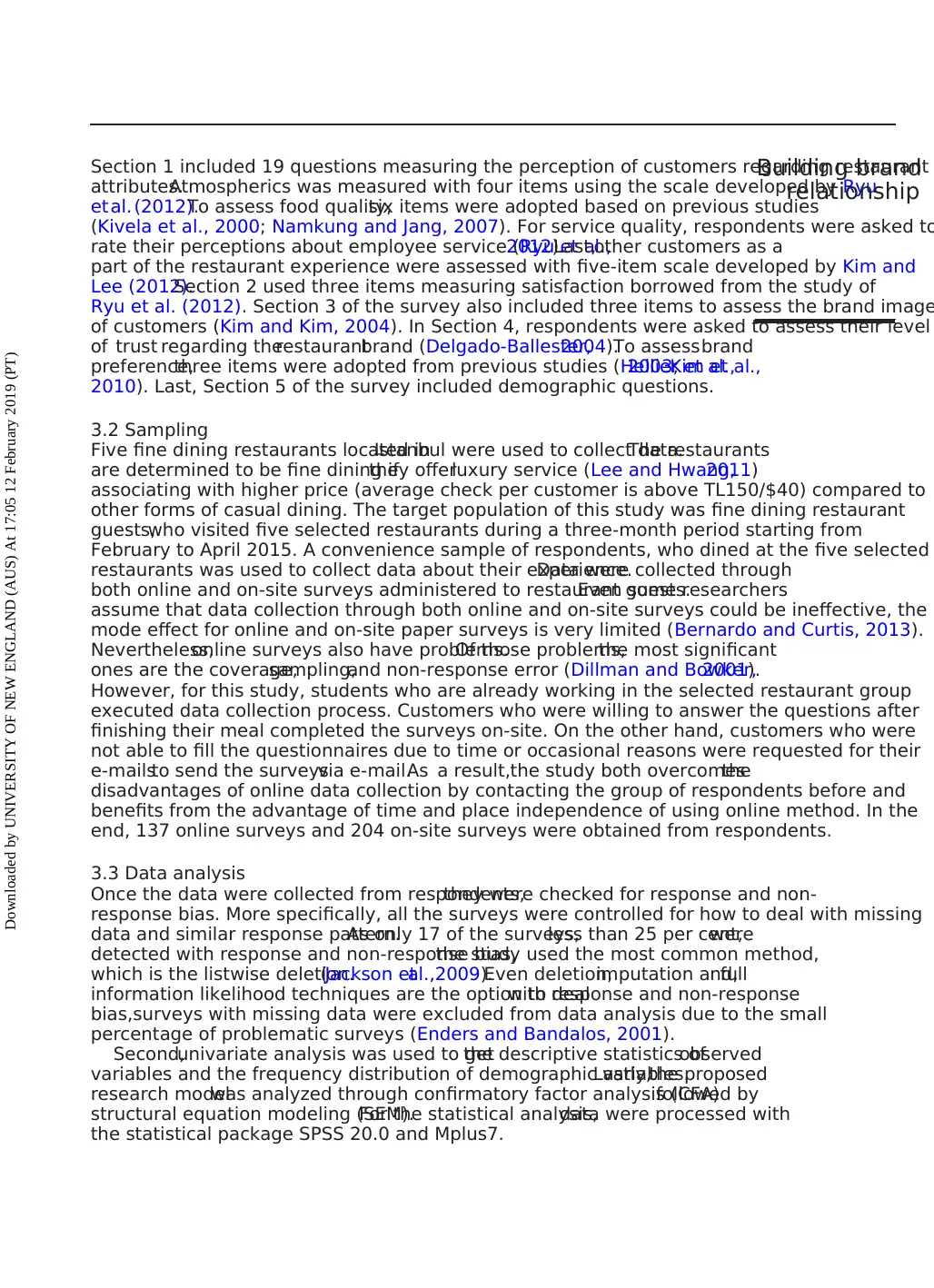
Section 1 included 19 questions measuring the perception of customers regarding restaurant
attributes.Atmospherics was measured with four items using the scale developed by Ryu
etal. (2012).To assess food quality,six items were adopted based on previous studies
(Kivela et al., 2000; Namkung and Jang, 2007). For service quality, respondents were asked to
rate their perceptions about employee service (Ryu et al.,2012).Last,other customers as a
part of the restaurant experience were assessed with five-item scale developed by Kim and
Lee (2012).Section 2 used three items measuring satisfaction borrowed from the study of
Ryu et al. (2012). Section 3 of the survey also included three items to assess the brand image
of customers (Kim and Kim, 2004). In Section 4, respondents were asked to assess their level
of trust regarding therestaurantbrand (Delgado-Ballester,2004).To assessbrand
preference,three items were adopted from previous studies (Hellier et al.,2003;Kim et al.,
2010). Last, Section 5 of the survey included demographic questions.
3.2 Sampling
Five fine dining restaurants located in_Istanbul were used to collect data.The restaurants
are determined to be fine dining ifthey offerluxury service (Lee and Hwang,2011)
associating with higher price (average check per customer is above TL150/$40) compared to
other forms of casual dining. The target population of this study was fine dining restaurant
guests,who visited five selected restaurants during a three-month period starting from
February to April 2015. A convenience sample of respondents, who dined at the five selected
restaurants was used to collect data about their experience.Data were collected through
both online and on-site surveys administered to restaurant guests.Even some researchers
assume that data collection through both online and on-site surveys could be ineffective, the
mode effect for online and on-site paper surveys is very limited (Bernardo and Curtis, 2013).
Nevertheless,online surveys also have problems.Of those problems,the most significant
ones are the coverage,sampling,and non-response error (Dillman and Bowker,2001).
However, for this study, students who are already working in the selected restaurant group
executed data collection process. Customers who were willing to answer the questions after
finishing their meal completed the surveys on-site. On the other hand, customers who were
not able to fill the questionnaires due to time or occasional reasons were requested for their
e-mailsto send the surveysvia e-mail.As a result,the study both overcomesthe
disadvantages of online data collection by contacting the group of respondents before and
benefits from the advantage of time and place independence of using online method. In the
end, 137 online surveys and 204 on-site surveys were obtained from respondents.
3.3 Data analysis
Once the data were collected from respondents,they were checked for response and non-
response bias. More specifically, all the surveys were controlled for how to deal with missing
data and similar response pattern.As only 17 of the surveys,less than 25 per cent,were
detected with response and non-response bias,the study used the most common method,
which is the listwise deletion.(Jackson etal.,2009).Even deletion,imputation and,full
information likelihood techniques are the option to dealwith response and non-response
bias,surveys with missing data were excluded from data analysis due to the small
percentage of problematic surveys (Enders and Bandalos, 2001).
Second,univariate analysis was used to getthe descriptive statistics ofobserved
variables and the frequency distribution of demographic variables.Lastly,the proposed
research modelwas analyzed through confirmatory factor analysis (CFA)followed by
structural equation modeling (SEM).For the statistical analysis,data were processed with
the statistical package SPSS 20.0 and Mplus7.
Building brand
relationship
Downloaded by UNIVERSITY OF NEW ENGLAND (AUS) At 17:05 12 February 2019 (PT)
attributes.Atmospherics was measured with four items using the scale developed by Ryu
etal. (2012).To assess food quality,six items were adopted based on previous studies
(Kivela et al., 2000; Namkung and Jang, 2007). For service quality, respondents were asked to
rate their perceptions about employee service (Ryu et al.,2012).Last,other customers as a
part of the restaurant experience were assessed with five-item scale developed by Kim and
Lee (2012).Section 2 used three items measuring satisfaction borrowed from the study of
Ryu et al. (2012). Section 3 of the survey also included three items to assess the brand image
of customers (Kim and Kim, 2004). In Section 4, respondents were asked to assess their level
of trust regarding therestaurantbrand (Delgado-Ballester,2004).To assessbrand
preference,three items were adopted from previous studies (Hellier et al.,2003;Kim et al.,
2010). Last, Section 5 of the survey included demographic questions.
3.2 Sampling
Five fine dining restaurants located in_Istanbul were used to collect data.The restaurants
are determined to be fine dining ifthey offerluxury service (Lee and Hwang,2011)
associating with higher price (average check per customer is above TL150/$40) compared to
other forms of casual dining. The target population of this study was fine dining restaurant
guests,who visited five selected restaurants during a three-month period starting from
February to April 2015. A convenience sample of respondents, who dined at the five selected
restaurants was used to collect data about their experience.Data were collected through
both online and on-site surveys administered to restaurant guests.Even some researchers
assume that data collection through both online and on-site surveys could be ineffective, the
mode effect for online and on-site paper surveys is very limited (Bernardo and Curtis, 2013).
Nevertheless,online surveys also have problems.Of those problems,the most significant
ones are the coverage,sampling,and non-response error (Dillman and Bowker,2001).
However, for this study, students who are already working in the selected restaurant group
executed data collection process. Customers who were willing to answer the questions after
finishing their meal completed the surveys on-site. On the other hand, customers who were
not able to fill the questionnaires due to time or occasional reasons were requested for their
e-mailsto send the surveysvia e-mail.As a result,the study both overcomesthe
disadvantages of online data collection by contacting the group of respondents before and
benefits from the advantage of time and place independence of using online method. In the
end, 137 online surveys and 204 on-site surveys were obtained from respondents.
3.3 Data analysis
Once the data were collected from respondents,they were checked for response and non-
response bias. More specifically, all the surveys were controlled for how to deal with missing
data and similar response pattern.As only 17 of the surveys,less than 25 per cent,were
detected with response and non-response bias,the study used the most common method,
which is the listwise deletion.(Jackson etal.,2009).Even deletion,imputation and,full
information likelihood techniques are the option to dealwith response and non-response
bias,surveys with missing data were excluded from data analysis due to the small
percentage of problematic surveys (Enders and Bandalos, 2001).
Second,univariate analysis was used to getthe descriptive statistics ofobserved
variables and the frequency distribution of demographic variables.Lastly,the proposed
research modelwas analyzed through confirmatory factor analysis (CFA)followed by
structural equation modeling (SEM).For the statistical analysis,data were processed with
the statistical package SPSS 20.0 and Mplus7.
Building brand
relationship
Downloaded by UNIVERSITY OF NEW ENGLAND (AUS) At 17:05 12 February 2019 (PT)
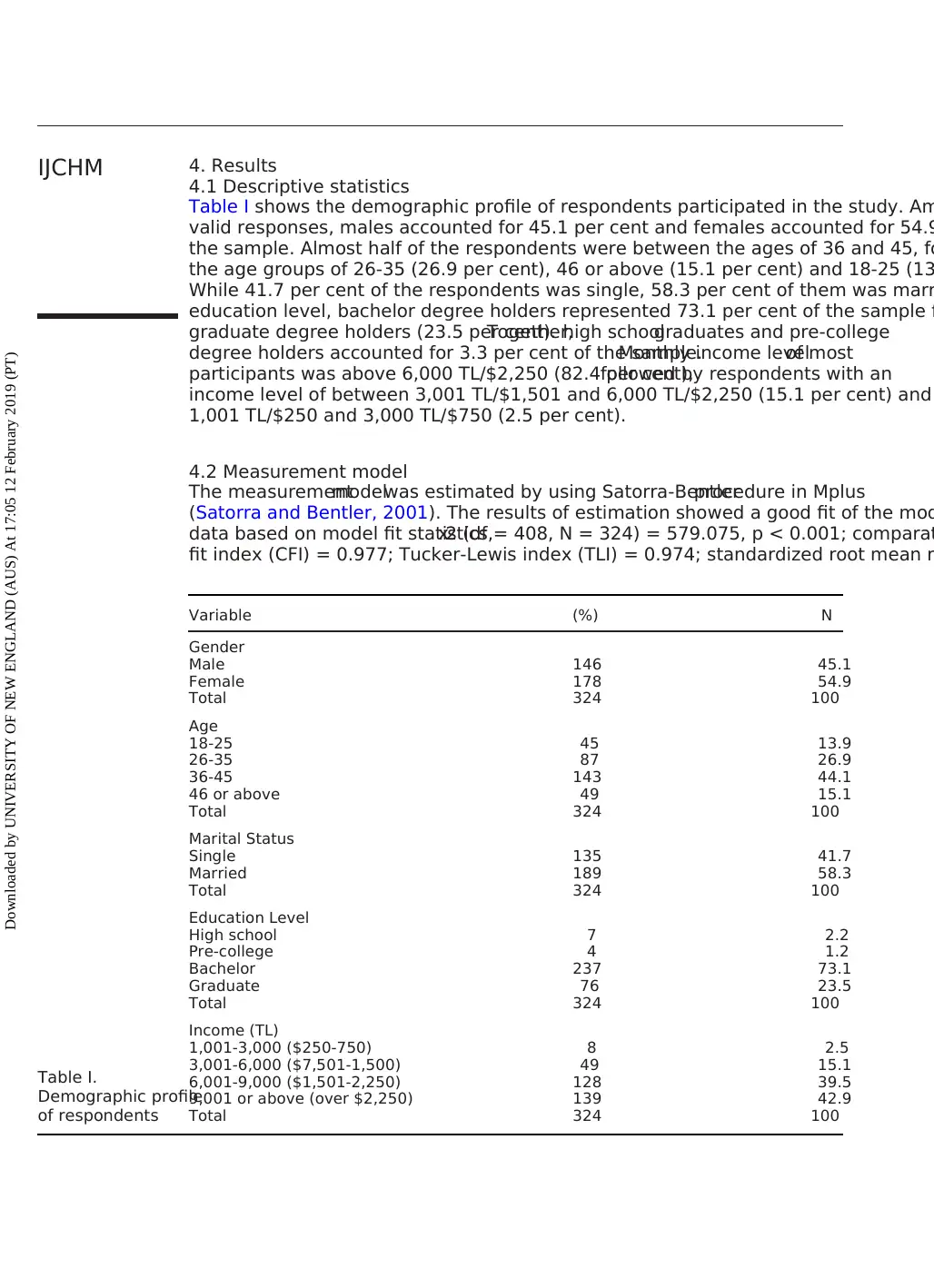
4. Results
4.1 Descriptive statistics
Table I shows the demographic profile of respondents participated in the study. Am
valid responses, males accounted for 45.1 per cent and females accounted for 54.9
the sample. Almost half of the respondents were between the ages of 36 and 45, fo
the age groups of 26-35 (26.9 per cent), 46 or above (15.1 per cent) and 18-25 (13
While 41.7 per cent of the respondents was single, 58.3 per cent of them was marr
education level, bachelor degree holders represented 73.1 per cent of the sample f
graduate degree holders (23.5 per cent).Together,high schoolgraduates and pre-college
degree holders accounted for 3.3 per cent of the sample.Monthly income levelof most
participants was above 6,000 TL/$2,250 (82.4 per cent),followed by respondents with an
income level of between 3,001 TL/$1,501 and 6,000 TL/$2,250 (15.1 per cent) and
1,001 TL/$250 and 3,000 TL/$750 (2.5 per cent).
4.2 Measurement model
The measurementmodelwas estimated by using Satorra-Bentlerprocedure in Mplus
(Satorra and Bentler, 2001). The results of estimation showed a good fit of the mod
data based on model fit statistics,x2 (df = 408, N = 324) = 579.075, p < 0.001; comparat
fit index (CFI) = 0.977; Tucker-Lewis index (TLI) = 0.974; standardized root mean r
Table I.
Demographic profile
of respondents
Variable (%) N
Gender
Male 146 45.1
Female 178 54.9
Total 324 100
Age
18-25 45 13.9
26-35 87 26.9
36-45 143 44.1
46 or above 49 15.1
Total 324 100
Marital Status
Single 135 41.7
Married 189 58.3
Total 324 100
Education Level
High school 7 2.2
Pre-college 4 1.2
Bachelor 237 73.1
Graduate 76 23.5
Total 324 100
Income (TL)
1,001-3,000 ($250-750) 8 2.5
3,001-6,000 ($7,501-1,500) 49 15.1
6,001-9,000 ($1,501-2,250) 128 39.5
9,001 or above (over $2,250) 139 42.9
Total 324 100
IJCHM
Downloaded by UNIVERSITY OF NEW ENGLAND (AUS) At 17:05 12 February 2019 (PT)
4.1 Descriptive statistics
Table I shows the demographic profile of respondents participated in the study. Am
valid responses, males accounted for 45.1 per cent and females accounted for 54.9
the sample. Almost half of the respondents were between the ages of 36 and 45, fo
the age groups of 26-35 (26.9 per cent), 46 or above (15.1 per cent) and 18-25 (13
While 41.7 per cent of the respondents was single, 58.3 per cent of them was marr
education level, bachelor degree holders represented 73.1 per cent of the sample f
graduate degree holders (23.5 per cent).Together,high schoolgraduates and pre-college
degree holders accounted for 3.3 per cent of the sample.Monthly income levelof most
participants was above 6,000 TL/$2,250 (82.4 per cent),followed by respondents with an
income level of between 3,001 TL/$1,501 and 6,000 TL/$2,250 (15.1 per cent) and
1,001 TL/$250 and 3,000 TL/$750 (2.5 per cent).
4.2 Measurement model
The measurementmodelwas estimated by using Satorra-Bentlerprocedure in Mplus
(Satorra and Bentler, 2001). The results of estimation showed a good fit of the mod
data based on model fit statistics,x2 (df = 408, N = 324) = 579.075, p < 0.001; comparat
fit index (CFI) = 0.977; Tucker-Lewis index (TLI) = 0.974; standardized root mean r
Table I.
Demographic profile
of respondents
Variable (%) N
Gender
Male 146 45.1
Female 178 54.9
Total 324 100
Age
18-25 45 13.9
26-35 87 26.9
36-45 143 44.1
46 or above 49 15.1
Total 324 100
Marital Status
Single 135 41.7
Married 189 58.3
Total 324 100
Education Level
High school 7 2.2
Pre-college 4 1.2
Bachelor 237 73.1
Graduate 76 23.5
Total 324 100
Income (TL)
1,001-3,000 ($250-750) 8 2.5
3,001-6,000 ($7,501-1,500) 49 15.1
6,001-9,000 ($1,501-2,250) 128 39.5
9,001 or above (over $2,250) 139 42.9
Total 324 100
IJCHM
Downloaded by UNIVERSITY OF NEW ENGLAND (AUS) At 17:05 12 February 2019 (PT)
⊘ This is a preview!⊘
Do you want full access?
Subscribe today to unlock all pages.

Trusted by 1+ million students worldwide
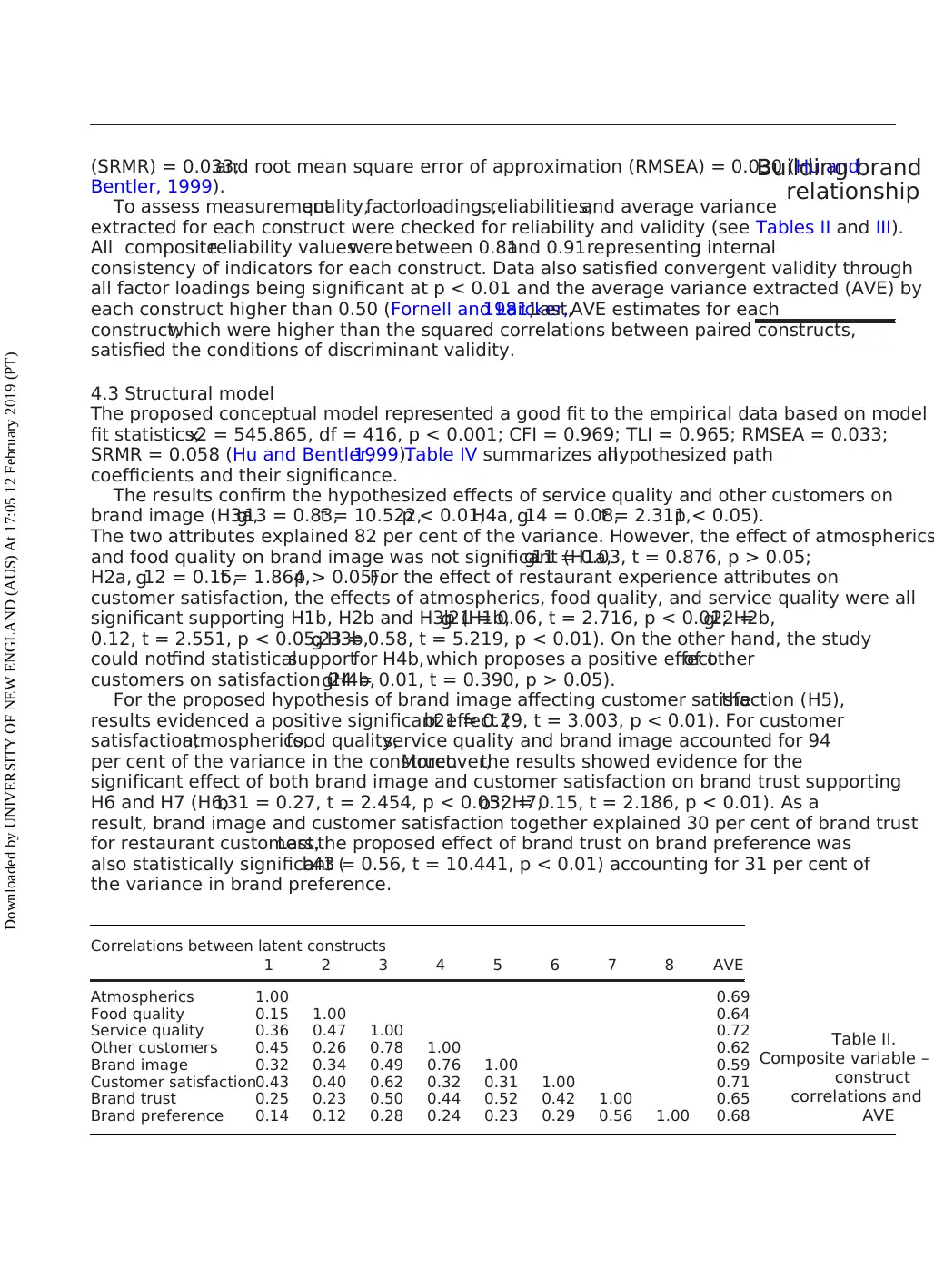
(SRMR) = 0.033;and root mean square error of approximation (RMSEA) = 0.030 (Hu and
Bentler, 1999).
To assess measurementquality,factorloadings,reliabilities,and average variance
extracted for each construct were checked for reliability and validity (see Tables II and III).
All compositereliability valueswere between 0.81and 0.91representing internal
consistency of indicators for each construct. Data also satisfied convergent validity through
all factor loadings being significant at p < 0.01 and the average variance extracted (AVE) by
each construct higher than 0.50 (Fornell and Larcker,1981).Last,AVE estimates for each
construct,which were higher than the squared correlations between paired constructs,
satisfied the conditions of discriminant validity.
4.3 Structural model
The proposed conceptual model represented a good fit to the empirical data based on model
fit statistics,x2 = 545.865, df = 416, p < 0.001; CFI = 0.969; TLI = 0.965; RMSEA = 0.033;
SRMR = 0.058 (Hu and Bentler,1999).Table IV summarizes allhypothesized path
coefficients and their significance.
The results confirm the hypothesized effects of service quality and other customers on
brand image (H3a,g13 = 0.83,t = 10.522,p < 0.01;H4a, g14 = 0.08,t = 2.311,p < 0.05).
The two attributes explained 82 per cent of the variance. However, the effect of atmospherics
and food quality on brand image was not significant (H1a,g11 = 0.03, t = 0.876, p > 0.05;
H2a, g12 = 0.15,t = 1.864,p > 0.05).For the effect of restaurant experience attributes on
customer satisfaction, the effects of atmospherics, food quality, and service quality were all
significant supporting H1b, H2b and H3b (H1b,g21 = 0.06, t = 2.716, p < 0.01; H2b,g22 =
0.12, t = 2.551, p < 0.05; H3b,g23 = 0.58, t = 5.219, p < 0.01). On the other hand, the study
could notfind statisticalsupportfor H4b,which proposes a positive effectof other
customers on satisfaction (H4b,g24 = 0.01, t = 0.390, p > 0.05).
For the proposed hypothesis of brand image affecting customer satisfaction (H5),the
results evidenced a positive significant effect (b21 = 0.29, t = 3.003, p < 0.01). For customer
satisfaction;atmospherics,food quality,service quality and brand image accounted for 94
per cent of the variance in the construct.Moreover,the results showed evidence for the
significant effect of both brand image and customer satisfaction on brand trust supporting
H6 and H7 (H6,b31 = 0.27, t = 2.454, p < 0.05; H7,b32 = 0.15, t = 2.186, p < 0.01). As a
result, brand image and customer satisfaction together explained 30 per cent of brand trust
for restaurant customers.Last,the proposed effect of brand trust on brand preference was
also statistically significant (b43 = 0.56, t = 10.441, p < 0.01) accounting for 31 per cent of
the variance in brand preference.
Table II.
Composite variable –
construct
correlations and
AVE
Correlations between latent constructs
1 2 3 4 5 6 7 8 AVE
Atmospherics 1.00 0.69
Food quality 0.15 1.00 0.64
Service quality 0.36 0.47 1.00 0.72
Other customers 0.45 0.26 0.78 1.00 0.62
Brand image 0.32 0.34 0.49 0.76 1.00 0.59
Customer satisfaction0.43 0.40 0.62 0.32 0.31 1.00 0.71
Brand trust 0.25 0.23 0.50 0.44 0.52 0.42 1.00 0.65
Brand preference 0.14 0.12 0.28 0.24 0.23 0.29 0.56 1.00 0.68
Building brand
relationship
Downloaded by UNIVERSITY OF NEW ENGLAND (AUS) At 17:05 12 February 2019 (PT)
Bentler, 1999).
To assess measurementquality,factorloadings,reliabilities,and average variance
extracted for each construct were checked for reliability and validity (see Tables II and III).
All compositereliability valueswere between 0.81and 0.91representing internal
consistency of indicators for each construct. Data also satisfied convergent validity through
all factor loadings being significant at p < 0.01 and the average variance extracted (AVE) by
each construct higher than 0.50 (Fornell and Larcker,1981).Last,AVE estimates for each
construct,which were higher than the squared correlations between paired constructs,
satisfied the conditions of discriminant validity.
4.3 Structural model
The proposed conceptual model represented a good fit to the empirical data based on model
fit statistics,x2 = 545.865, df = 416, p < 0.001; CFI = 0.969; TLI = 0.965; RMSEA = 0.033;
SRMR = 0.058 (Hu and Bentler,1999).Table IV summarizes allhypothesized path
coefficients and their significance.
The results confirm the hypothesized effects of service quality and other customers on
brand image (H3a,g13 = 0.83,t = 10.522,p < 0.01;H4a, g14 = 0.08,t = 2.311,p < 0.05).
The two attributes explained 82 per cent of the variance. However, the effect of atmospherics
and food quality on brand image was not significant (H1a,g11 = 0.03, t = 0.876, p > 0.05;
H2a, g12 = 0.15,t = 1.864,p > 0.05).For the effect of restaurant experience attributes on
customer satisfaction, the effects of atmospherics, food quality, and service quality were all
significant supporting H1b, H2b and H3b (H1b,g21 = 0.06, t = 2.716, p < 0.01; H2b,g22 =
0.12, t = 2.551, p < 0.05; H3b,g23 = 0.58, t = 5.219, p < 0.01). On the other hand, the study
could notfind statisticalsupportfor H4b,which proposes a positive effectof other
customers on satisfaction (H4b,g24 = 0.01, t = 0.390, p > 0.05).
For the proposed hypothesis of brand image affecting customer satisfaction (H5),the
results evidenced a positive significant effect (b21 = 0.29, t = 3.003, p < 0.01). For customer
satisfaction;atmospherics,food quality,service quality and brand image accounted for 94
per cent of the variance in the construct.Moreover,the results showed evidence for the
significant effect of both brand image and customer satisfaction on brand trust supporting
H6 and H7 (H6,b31 = 0.27, t = 2.454, p < 0.05; H7,b32 = 0.15, t = 2.186, p < 0.01). As a
result, brand image and customer satisfaction together explained 30 per cent of brand trust
for restaurant customers.Last,the proposed effect of brand trust on brand preference was
also statistically significant (b43 = 0.56, t = 10.441, p < 0.01) accounting for 31 per cent of
the variance in brand preference.
Table II.
Composite variable –
construct
correlations and
AVE
Correlations between latent constructs
1 2 3 4 5 6 7 8 AVE
Atmospherics 1.00 0.69
Food quality 0.15 1.00 0.64
Service quality 0.36 0.47 1.00 0.72
Other customers 0.45 0.26 0.78 1.00 0.62
Brand image 0.32 0.34 0.49 0.76 1.00 0.59
Customer satisfaction0.43 0.40 0.62 0.32 0.31 1.00 0.71
Brand trust 0.25 0.23 0.50 0.44 0.52 0.42 1.00 0.65
Brand preference 0.14 0.12 0.28 0.24 0.23 0.29 0.56 1.00 0.68
Building brand
relationship
Downloaded by UNIVERSITY OF NEW ENGLAND (AUS) At 17:05 12 February 2019 (PT)
Paraphrase This Document
Need a fresh take? Get an instant paraphrase of this document with our AI Paraphraser
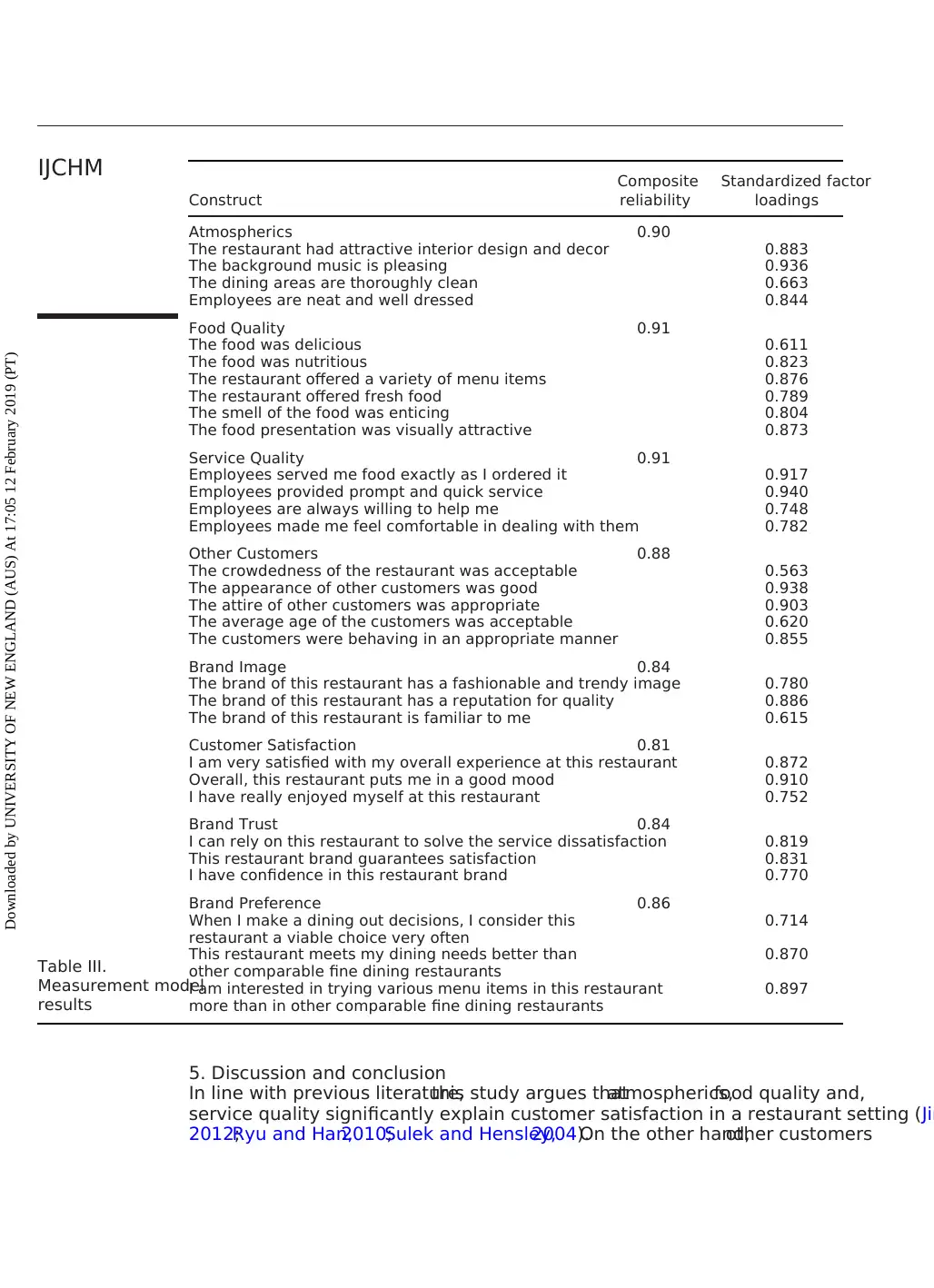
5. Discussion and conclusion
In line with previous literature,this study argues thatatmospherics,food quality and,
service quality significantly explain customer satisfaction in a restaurant setting (Jin
2012;Ryu and Han,2010;Sulek and Hensley,2004).On the other hand,other customers
Table III.
Measurement model
results
Construct
Composite
reliability
Standardized factor
loadings
Atmospherics 0.90
The restaurant had attractive interior design and decor 0.883
The background music is pleasing 0.936
The dining areas are thoroughly clean 0.663
Employees are neat and well dressed 0.844
Food Quality 0.91
The food was delicious 0.611
The food was nutritious 0.823
The restaurant offered a variety of menu items 0.876
The restaurant offered fresh food 0.789
The smell of the food was enticing 0.804
The food presentation was visually attractive 0.873
Service Quality 0.91
Employees served me food exactly as I ordered it 0.917
Employees provided prompt and quick service 0.940
Employees are always willing to help me 0.748
Employees made me feel comfortable in dealing with them 0.782
Other Customers 0.88
The crowdedness of the restaurant was acceptable 0.563
The appearance of other customers was good 0.938
The attire of other customers was appropriate 0.903
The average age of the customers was acceptable 0.620
The customers were behaving in an appropriate manner 0.855
Brand Image 0.84
The brand of this restaurant has a fashionable and trendy image 0.780
The brand of this restaurant has a reputation for quality 0.886
The brand of this restaurant is familiar to me 0.615
Customer Satisfaction 0.81
I am very satisfied with my overall experience at this restaurant 0.872
Overall, this restaurant puts me in a good mood 0.910
I have really enjoyed myself at this restaurant 0.752
Brand Trust 0.84
I can rely on this restaurant to solve the service dissatisfaction 0.819
This restaurant brand guarantees satisfaction 0.831
I have confidence in this restaurant brand 0.770
Brand Preference 0.86
When I make a dining out decisions, I consider this
restaurant a viable choice very often
0.714
This restaurant meets my dining needs better than
other comparable fine dining restaurants
0.870
I am interested in trying various menu items in this restaurant
more than in other comparable fine dining restaurants
0.897
IJCHM
Downloaded by UNIVERSITY OF NEW ENGLAND (AUS) At 17:05 12 February 2019 (PT)
In line with previous literature,this study argues thatatmospherics,food quality and,
service quality significantly explain customer satisfaction in a restaurant setting (Jin
2012;Ryu and Han,2010;Sulek and Hensley,2004).On the other hand,other customers
Table III.
Measurement model
results
Construct
Composite
reliability
Standardized factor
loadings
Atmospherics 0.90
The restaurant had attractive interior design and decor 0.883
The background music is pleasing 0.936
The dining areas are thoroughly clean 0.663
Employees are neat and well dressed 0.844
Food Quality 0.91
The food was delicious 0.611
The food was nutritious 0.823
The restaurant offered a variety of menu items 0.876
The restaurant offered fresh food 0.789
The smell of the food was enticing 0.804
The food presentation was visually attractive 0.873
Service Quality 0.91
Employees served me food exactly as I ordered it 0.917
Employees provided prompt and quick service 0.940
Employees are always willing to help me 0.748
Employees made me feel comfortable in dealing with them 0.782
Other Customers 0.88
The crowdedness of the restaurant was acceptable 0.563
The appearance of other customers was good 0.938
The attire of other customers was appropriate 0.903
The average age of the customers was acceptable 0.620
The customers were behaving in an appropriate manner 0.855
Brand Image 0.84
The brand of this restaurant has a fashionable and trendy image 0.780
The brand of this restaurant has a reputation for quality 0.886
The brand of this restaurant is familiar to me 0.615
Customer Satisfaction 0.81
I am very satisfied with my overall experience at this restaurant 0.872
Overall, this restaurant puts me in a good mood 0.910
I have really enjoyed myself at this restaurant 0.752
Brand Trust 0.84
I can rely on this restaurant to solve the service dissatisfaction 0.819
This restaurant brand guarantees satisfaction 0.831
I have confidence in this restaurant brand 0.770
Brand Preference 0.86
When I make a dining out decisions, I consider this
restaurant a viable choice very often
0.714
This restaurant meets my dining needs better than
other comparable fine dining restaurants
0.870
I am interested in trying various menu items in this restaurant
more than in other comparable fine dining restaurants
0.897
IJCHM
Downloaded by UNIVERSITY OF NEW ENGLAND (AUS) At 17:05 12 February 2019 (PT)
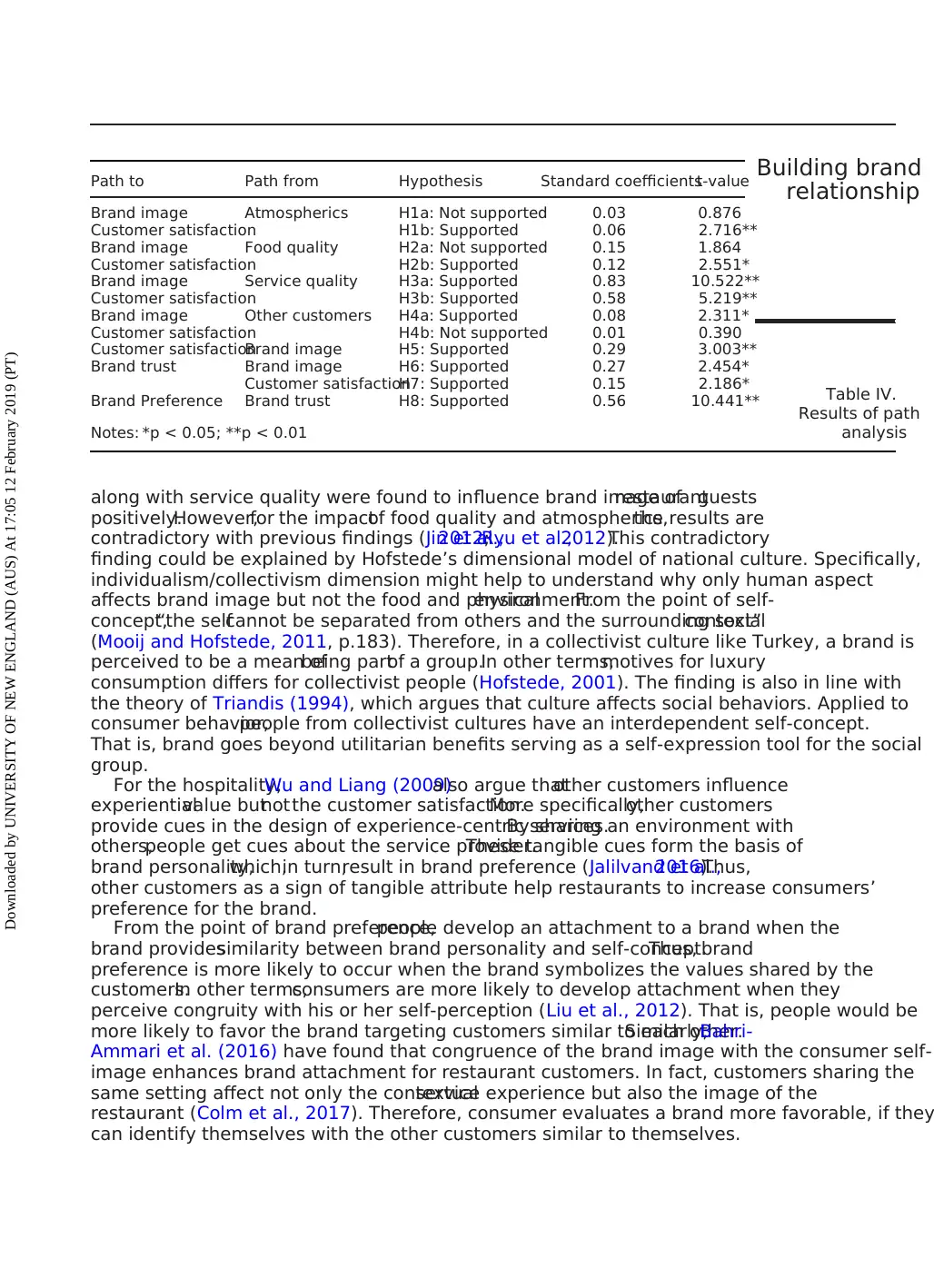
along with service quality were found to influence brand image ofrestaurantguests
positively.However,for the impactof food quality and atmospherics,the results are
contradictory with previous findings (Jin et al.,2012;Ryu et al.,2012).This contradictory
finding could be explained by Hofstede’s dimensional model of national culture. Specifically,
individualism/collectivism dimension might help to understand why only human aspect
affects brand image but not the food and physicalenvironment.From the point of self-
concept,“the selfcannot be separated from others and the surrounding socialcontext”
(Mooij and Hofstede, 2011, p.183). Therefore, in a collectivist culture like Turkey, a brand is
perceived to be a mean ofbeing partof a group.In other terms,motives for luxury
consumption differs for collectivist people (Hofstede, 2001). The finding is also in line with
the theory of Triandis (1994), which argues that culture affects social behaviors. Applied to
consumer behavior,people from collectivist cultures have an interdependent self-concept.
That is, brand goes beyond utilitarian benefits serving as a self-expression tool for the social
group.
For the hospitality,Wu and Liang (2009)also argue thatother customers influence
experientialvalue butnotthe customer satisfaction.More specifically,other customers
provide cues in the design of experience-centric services.By sharing an environment with
others,people get cues about the service provider.These tangible cues form the basis of
brand personality,which,in turn,result in brand preference (Jalilvand et al.,2016).Thus,
other customers as a sign of tangible attribute help restaurants to increase consumers’
preference for the brand.
From the point of brand preference,people develop an attachment to a brand when the
brand providessimilarity between brand personality and self-concept.Thus, brand
preference is more likely to occur when the brand symbolizes the values shared by the
customers.In other terms,consumers are more likely to develop attachment when they
perceive congruity with his or her self-perception (Liu et al., 2012). That is, people would be
more likely to favor the brand targeting customers similar to each other.Similarly,Bahri-
Ammari et al. (2016) have found that congruence of the brand image with the consumer self-
image enhances brand attachment for restaurant customers. In fact, customers sharing the
same setting affect not only the contextualservice experience but also the image of the
restaurant (Colm et al., 2017). Therefore, consumer evaluates a brand more favorable, if they
can identify themselves with the other customers similar to themselves.
Table IV.
Results of path
analysis
Path to Path from Hypothesis Standard coefficientst-value
Brand image
Customer satisfaction
Atmospherics H1a: Not supported
H1b: Supported
0.03
0.06
0.876
2.716**
Brand image
Customer satisfaction
Food quality H2a: Not supported
H2b: Supported
0.15
0.12
1.864
2.551*
Brand image
Customer satisfaction
Service quality H3a: Supported
H3b: Supported
0.83
0.58
10.522**
5.219**
Brand image
Customer satisfaction
Other customers H4a: Supported
H4b: Not supported
0.08
0.01
2.311*
0.390
Customer satisfactionBrand image H5: Supported 0.29 3.003**
Brand trust Brand image
Customer satisfaction
H6: Supported
H7: Supported
0.27
0.15
2.454*
2.186*
Brand Preference Brand trust H8: Supported 0.56 10.441**
Notes: *p < 0.05; **p < 0.01
Building brand
relationship
Downloaded by UNIVERSITY OF NEW ENGLAND (AUS) At 17:05 12 February 2019 (PT)
positively.However,for the impactof food quality and atmospherics,the results are
contradictory with previous findings (Jin et al.,2012;Ryu et al.,2012).This contradictory
finding could be explained by Hofstede’s dimensional model of national culture. Specifically,
individualism/collectivism dimension might help to understand why only human aspect
affects brand image but not the food and physicalenvironment.From the point of self-
concept,“the selfcannot be separated from others and the surrounding socialcontext”
(Mooij and Hofstede, 2011, p.183). Therefore, in a collectivist culture like Turkey, a brand is
perceived to be a mean ofbeing partof a group.In other terms,motives for luxury
consumption differs for collectivist people (Hofstede, 2001). The finding is also in line with
the theory of Triandis (1994), which argues that culture affects social behaviors. Applied to
consumer behavior,people from collectivist cultures have an interdependent self-concept.
That is, brand goes beyond utilitarian benefits serving as a self-expression tool for the social
group.
For the hospitality,Wu and Liang (2009)also argue thatother customers influence
experientialvalue butnotthe customer satisfaction.More specifically,other customers
provide cues in the design of experience-centric services.By sharing an environment with
others,people get cues about the service provider.These tangible cues form the basis of
brand personality,which,in turn,result in brand preference (Jalilvand et al.,2016).Thus,
other customers as a sign of tangible attribute help restaurants to increase consumers’
preference for the brand.
From the point of brand preference,people develop an attachment to a brand when the
brand providessimilarity between brand personality and self-concept.Thus, brand
preference is more likely to occur when the brand symbolizes the values shared by the
customers.In other terms,consumers are more likely to develop attachment when they
perceive congruity with his or her self-perception (Liu et al., 2012). That is, people would be
more likely to favor the brand targeting customers similar to each other.Similarly,Bahri-
Ammari et al. (2016) have found that congruence of the brand image with the consumer self-
image enhances brand attachment for restaurant customers. In fact, customers sharing the
same setting affect not only the contextualservice experience but also the image of the
restaurant (Colm et al., 2017). Therefore, consumer evaluates a brand more favorable, if they
can identify themselves with the other customers similar to themselves.
Table IV.
Results of path
analysis
Path to Path from Hypothesis Standard coefficientst-value
Brand image
Customer satisfaction
Atmospherics H1a: Not supported
H1b: Supported
0.03
0.06
0.876
2.716**
Brand image
Customer satisfaction
Food quality H2a: Not supported
H2b: Supported
0.15
0.12
1.864
2.551*
Brand image
Customer satisfaction
Service quality H3a: Supported
H3b: Supported
0.83
0.58
10.522**
5.219**
Brand image
Customer satisfaction
Other customers H4a: Supported
H4b: Not supported
0.08
0.01
2.311*
0.390
Customer satisfactionBrand image H5: Supported 0.29 3.003**
Brand trust Brand image
Customer satisfaction
H6: Supported
H7: Supported
0.27
0.15
2.454*
2.186*
Brand Preference Brand trust H8: Supported 0.56 10.441**
Notes: *p < 0.05; **p < 0.01
Building brand
relationship
Downloaded by UNIVERSITY OF NEW ENGLAND (AUS) At 17:05 12 February 2019 (PT)
⊘ This is a preview!⊘
Do you want full access?
Subscribe today to unlock all pages.

Trusted by 1+ million students worldwide
1 out of 20
Related Documents
Your All-in-One AI-Powered Toolkit for Academic Success.
+13062052269
info@desklib.com
Available 24*7 on WhatsApp / Email
![[object Object]](/_next/static/media/star-bottom.7253800d.svg)
Unlock your academic potential
Copyright © 2020–2025 A2Z Services. All Rights Reserved. Developed and managed by ZUCOL.





